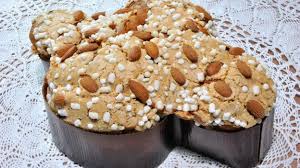|
|
|
|
|
|
LE ORIGINI DEL PANETTONE: PARTE II, LA STORIA
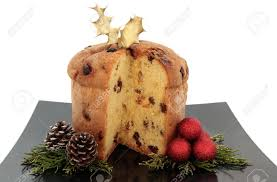
Ho trovato quest’articolo che parla dell’origine del Panettone,
il più famoso dolce di Natale in Italia. Siccome delle quattro
storie, due sono favole divertenti, e due sono storiche, le ho
divise in tue parti. Il sito da cui ho tratto questo articolo è
https://www.fanpage.it/il-panettone-le-origini-del-famoso-
dolce-natalizio-fra-tradizione-e-leggenda/; grazie mille a
Federica D'Alfonso per averlo scritto; la traduzione in inglese è
la mia.
Un’arte antichissima: In realtà la ricetta del panettone
risalirebbe addirittura al Medioevo: alcuni manoscritti del
Quattrocento raccontano l’usanza, diffusa sotto gli Sforza, di
celebrare il Natale concedendo a tutti di mangiare, almeno per
un giorno, un pane più ricco e dolce di quello degli altri giorni.
Ai fornai dell’epoca era infatti vietato di utilizzare farine
pregiate per impastare il pane per il popolo, ma il giorno di
Natale a tutti era permesso di deliziarsi con un impasto di
farina, burro e uova: una fetta di questo straordinario dolce
veniva conservata per l’anno successivo, in segno di augurio e
speranza di abbondanza.
La tradizione che vuole che il panettone sia nato a Pavia
anziché a Milano trova oltretutto testimonianza in alcuni
registri provenienti dal Collegio Borromeo: in un foglio del 1599
gli storici hanno rinvenuto delle annotazioni relative alle spese
per il pranzo di Natale, fra cui compare questo particolare tipo
di “pane”: si legge che per realizzare l’antenato del moderno
panettone furono necessarie tre libbre di burro, due di uvetta
e due once di spezie, ottenendo “13 pani grossi per dar alli
scolari il giorno di Natale”.
THE ORIGINS OF PANETTONE: PART II, THE HISTORY
I found this article which talks about the origin of Panettone,
the most famous Italian Christmas sweet. Since of the four
stories, two are amusing fairy tales, and two are historic, I
have divided them into two parts. The website where I found
this article ishttps://www.fanpage.it/il-panettone-le-origini-
del-famoso-dolce-natalizio-fra-tradizione-e-leggenda/; thank
you very much Federica D'Alfonso for having written it; the
translation is mine.
An ancient art: In reality the recipe for panettone dates as far
back at the Middle Ages: several manuscripts from the 1400’s
tell of the custom established under the Sforza Family, to
celebrate Christmas allowing everyone to eat, at least one
day, bread which was richer and sweeter than that of the
other days. The bakers of the time were prohibited to use
prized flour to make bread for the common folk, but on
Christmas day everyone was permitted to enjoy a mixture of
flour, butter and eggs: a slice of this extraordinary sweet was
put aside for the following year, as a symbol of good luck and
a hope for abundance.
The tradition that states the panettone was born in Pavia
instead of Milan finds proof above all in several records found
in the Collegio Borromeo: on a folio from 1599, historians
found annotations regarding the expenses for the Christmas
dinner, among which to buy this particular kind of “bread” we
read: that in order to make the ancestor of the
modernpanettone the following were necessary: three
pounds of butter, two pounds of raisins and two ounces of
spices, resulting in “13 large loaves to be given to the disciples
on Christmas day.”
Saturday, January 5, 2018
|
| |
|
Felice 2019
Una delle tradizioni di capodanno più diffuse in Italia è di
mangiare lenticchie;date la loro forma rotonda e piatta simile
ai soldi e il loro valore nutritivo, mangiare le lenticchie è un
auspicio per un anno ricco, abbondante. Spesso sono
consumate con il cotechino o lo zampone, anch’essi simboli di
prosperità.
Questa tradizione ha origine nell’antica Roma quando era
usanza regalare una “scarsella” (una tipica borsa di cuoio, che
di solito conteneva monete, era legata alla cintura) piena di
lenticchie, con l’augurio che si trasformassero in monete. Il
nome lenticchia, infatti, deriva dalla particolare forma a lente
di questi legumi, che ricorda quella di una moneta. Prima di
tutto, la forma rotonda e appiattita di questo legume, ricorda
le monete d'oro, inoltre anche la cottura, che ne fa aumentare
il volume, fa pensare a un accrescimento, quindi ad una
ricchezza crescente.

Happy 2019
One of the most common New Year’s traditions in Italy is to
eat lentils; given their round and flat shape, similar to money,
and their nutritive value, eating lentils is a wish for a rich and
abundant year. Often they are consumed with cotechino
(type of large pork sausage) or zampone (stuffed pig’s foot),
other symbols of prosperity.
This tradition has its origins in ancient Rome when it was a
common occurrence to give a “scarsarella” (a typical bag
made out of leather which usually contained coins and was
tied to a belt) full of lentils, with the wish that they would
transform themselves into coins, The name lentil, in fact
derives from the lens shape of this legume, similar to a coin.
Firstly, its round and flat shape, evokes a gold coin, and
secondly, when it is cooked its volume increases making one
think of increased wealth.
Saturday, December 29, 2018
|
|
| |
Ho trovato questo bellissimo augurio natalizio e vorrei
condividerlo: “Non abbiamo bisogno di regali ma di
presenza. Esserci è il regalo più grande che si possa
fare alle persone.”
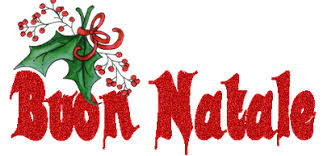
I found this lovely Christmas wish and I would like to
share it with you: “We don’t need gifts but presence.
Being there is the greatest gift someone could give
to other people.”
Saturday, December 22, 2018
|
|
| |
LE ORIGINI DEL PANETTONE: PARTE I: LE LEGGENDE
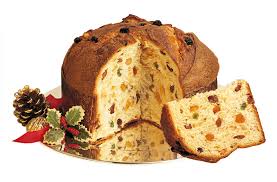
Ho trovato quest’articolo che parla dell’origine del Panettone,
il più famoso dolce di Natale in Italia. Siccome delle quattro
storie, due sono favole divertenti, e due sono storiche, le ho
divise in tue parti. Il sito da cui ho tratto questo articolo è
https://www.fanpage.it/il-panettone-le-origini-del-famoso-
dolce-natalizio-fra-tradizione-e-leggenda/; grazie mille a
Federica D'Alfonso per averlo scritto; la traduzione in inglese
è la mia.
Esistono due leggende, le più note, relative all’invenzione del
ricco dolce natalizio: la prima si avvicina ad una vera e propria
fiaba, raccontando le vicende amorose di Messer Ulivo degli
Atellani e Algisa, la bellissima figlia del fornaio. Ulivo, con
l’intenzione di conquistare la bella giovane ma anche
l’approvazione di suo padre, si fece assumere nel forno di
famiglia e provò ad inventare un dolce: impastando burro,
uova, miele, uvetta sultanina e la migliore farina del mulino
ottenne “il pane più buono di tutti”. Grazie al panettone i due
innamorati si sposarono e vissero felici e contenti.
Un’altra storia, meno idilliaca ma pur sempre fantasiosa, fa
risalire l’invenzione del panettone alla corte di Ludovico il
Moro. Il merito andrebbe ad uno sguattero delle cucine, Toni,
che per rimediare al pasticcio combinato dal cuoco, il quale
aveva bruciato il dolce da portare in tavola, propose di servire
ai nobili ospiti un pane al burro preparato da lui: l’esperimento
culinario del giovane piacque tanto a Ludovico il Moro da
convincerlo a dargli il suo nome, “pan di Toni”.
THE ORIGINS OF PANETTONE: PART I: THE LEGENDS
I found this article which talks about the origins of Panettone,
the most famous Italian Christmas sweet. Since of the four
stories, two are amusing fairy tales, and two are historic, I
have divided them into two parts. The website where I found
this article ishttps://www.fanpage.it/il-panettone-le-origini-
del-famoso-dolce-natalizio-fra-tradizione-e-leggenda/; thank
you very much Federica D'Alfonso for having written it; the
translation is mine.
There are two well-known legends regarding the invention of
the rich Christmas sweet; the first comes close to being a real
fable. It tells of the amorous exploits of Mr. Ulivo degli
Atellani and Algisa, the beautiful daughter of the baker. Ulivo,
wanting to win over the beautiful young woman as well as the
approval of her father, had himself hired in the family bakery
and tried to create a sweet; by kneading together butter,
eggs, honey, raisins and the best flour from the mill he ceated
“the best bread of them all”. Thanks to the panettone the two
lovers married and lived happily ever after.
Another story, less idyllic but still imaginary, has the story date
back to the court of Ludovico il Moro*. The credit goes to a
scullery boy, Toni, who, in order to fix the mess made by the
cook who had burned the sweet for that evening’s meal,
proposed to serve the noble guests a bread made with butter,
which he prepared himself. The culinary experiment of the
young man pleased Ludovico il Moro so much that he gave it
the boy’s name, “pan di Toni” (Toni’s bread—the Italian word
for bread is “pane”).
*We might as well learn some history while we are enjoying
ourselves: Ludovico il Moro(the Moor—1452-1508) was
Ludovico Sforza, Duke of Milan. He was considered a ruthless
prince and diplomatist as well as a patron of Leonardo da Vinci
and other artists.
Saturday, December 15, 2018
|
|
| |
LA PATATA AMERICANA ALIAS “SWEET POTATO”, PARTE III
 gnocchi di patate dolci gnocchi di patate dolci
Come sapete, mi piace unire le due parti di me stessa, di
trovare punti in comune tra il lato italiano e quello americano.
Thanksgiving è uno di quei giorni che mi sfida: come
s’incrociano tradizioni, cibi, storie diverse? In passato vi ho
descritto un pranzo tradizionale e vi ho anche dato una
ricetta per salsa di mirtilli rossi, ma manca qualcosa. Mi sono
messa a navigare l’internet e sono rimasta stupita quando ho
trovato l’articolo che segue. Siccome è un po’ lungo e tratta
di diverse parti d’Italia, ho deciso di dividerlo in tre,
rispettando la geografia del paese. Ecco la terza parte di:
La patata americana parla veneto e pugliese.
La patata zuccherina dell’agro leccese
Nel leccese la sua coltivazione è limitata alla fascia costiera
che dal capoluogo conduce verso Brindisi, nelle zone di
Frigole, Surbo, Squinzano, Trepuzzi. Nel Salento leccese la
patata americana viene chiamata ‘patata zuccherina‘ proprio
per il sapore dolce della radice tuberosa. In questa zona le
varietà coltivate sono la “rossa” e la “bianca” tradizionali. I
tuberi hanno forma irregolare, ovale o allungata, di colore
rosso-porpora-ocra a seconda della varietà; la polpa va dal
bianco al giallo. Si comincia a trovarla nei mercati da
settembre fino a novembre-dicembre, anche per questo è il
classico dolce “povero” del periodo natalizio.
THE SWEET POTATO AKA THE AMERICAN POTATO, PART III
 frittata di patate dolci con frittata di patate dolci con
gorgonzola
As you know, I like to combine the two parts of me, to try to
find common ground between the Italian and the American
sides. Thanksgiving is one of the days that challenges me:
how do we combine different traditions, foods and histories?
In the past I described a traditional dinner and I gave you a
recipe for cranberry sauce, but something is missing. I
started surfing the web and I was stunned when I found the
following article. Since it’s a little on the long side and it deals
with different parts of Italy, I have divided it in three,
respecting the geography of the country. Here is the third
part of: The American potato speaks Veneto and Pugliese:
The sugary agricultural potato of Lecce
In the area around Lecce (in Puglia, the heel of the Italian
boot) cultivation is limited to a costal swath which extends
from the regional capital (Bari) towards Brindisi, in the areas
of Frigole, Surbo, Squinzano, Trepuzzi. In the Salento area
of Lecce, the American potato is called “sugary potato”
specifically due to the sweet flavor of this tuberous root. In
this area, the varieties that are cultivated are traditionally
“the red” and “the white”. The tubers have irregular shapes,
oval or elongated; their color is red-purple-ochre depending
on the variety; the flesh varies between white and yellow. It
can be found in the markets from September until November-
December, and for this reason it is considered the classical
“poor” sweet of the Christmas season.
 gelato di patate dolci gelato di patate dolci
BUON APPETITO
https://www.lacucinaitaliana.it/news/in-primo-piano/patata-
americana-dolce-varieta-italiane/
Saturday, December 8, 2018
|
|
| |
LA PATATA AMERICANA ALIAS “SWEET POTATO”, PARTE II

Come sapete, mi piace unire le due parti di me stessa, di
trovare punti in comune tra il lato italiano e quello americano.
Thanksgiving è uno di quei giorni che mi sfida: come
s’incrociano tradizioni, cibi, storie diverse? In passato vi ho
descritto un pranzo tradizionale e vi ho anche dato una
ricetta per salsa di mirtilli rossi, ma manca qualcosa. Mi sono
messa a navigare l’internet e sono rimasta stupita quando ho
trovato l’articolo che segue. Siccome è un po’ lungo e tratta
di diverse parti d’Italia, ho deciso di dividerlo in tre,
rispettando la geografia del paese. Ecco la seconda parte di:
La patata americana parla veneto e pugliese.
La patata americana di Anguillara e Stroppare
La patata americana arrivò in Italia subito dopo la scoperta
dell’America. Intorno alla fine dell’Ottocento il Conte Antonio
Donà dalle Rose ne iniziò la coltivazione intensiva nei propri
terreni in provincia di Rovigo, a ridosso del fiume Adige. Da
qui la coltura si estese in territorio padovano, sull’opposta
sponda dell’Adige, affermandosi particolarmente nella zona
di Anguillara e nella frazione di Stroppare. La pubblicazione
“Aspetti economici della Provincia di Padova”, edita nel 1934,
ne rileva una produzione di 800 quintali già dal 1914,
divenuti 23.000 nel 1928.
L’importanza della coltura è sottolineata nel maggio 1955
dai parroci del luogo: “Ogni sera il fioretto in chiesa, … non
molto frequentato: … la popolazione è molto occupata per la
piantagione delle patate”.
THE SWEET POTATO AKA THE AMERICAN POTATO, PART II
As you know, I like to combine the two parts of me, to try to
find common ground between the Italian and the American
sides. Thanksgiving is one of the days that challenges me:
how do we combine different traditions, foods and histories?
In the past I described a traditional dinner and I gave you a
recipe for cranberry sauce, but something is missing. I
started surfing the web and I was stunned when I found the
following article. Since it’s a little on the long side and it deals
with different parts of Italy, I have divided it in three,
respecting the geography of the country. Here is the second
part of: The American potato speaks Veneto and Pugliese:
The American potato from Anguillara e Stroppare
The American potato arrived in Italy immediately after the
discovery of America. Around the end of the 1800’s, Count
Antonio Donà dalle Rose began its intensive cultivation on
his lands in the province of Rovigo, very close to the Adige
River. From here the cultivation extended into the area
around Padova, on the opposite bank of the Adige,
establishing itself primarily in the area of Angullara and in
the small town of Stroppare. The journal “Economic
Aspects of the Province of Padua” from 1934, describes a
production of 800 quintals [1 quintal = 100 kilograms] as
early as 1914, which by 1928 had reached 23,000 quintals.
The importance of this cultivation is underscored in May of
1955 by the parish priests of the area: “Every evening in
church the prayer service…is not well attended…the
population is very busy with planting potatoes”.
https://www.lacucinaitaliana.it/news/in-primo-piano/
patata-americana-dolce-varieta-italiane/
Saturday, December 1, 2018
|
|
| |
LA PATATA AMERICANA ALIAS “SWEET POTATO”, PARTE I

Come sapete, mi piace unire le due parti di me stessa, di
trovare punti in comune tra il lato italiano e quello
americano. Thanksgiving è uno di quei giorni che mi sfida:
come s’incrociano tradizioni, cibi, storie diverse? In
passato vi ho descritto un pranzo tradizionale e vi ho anche
dato una ricetta per salsa di mirtilli rossi, ma manca
qualcosa. Mi sono messa a navigare l’internet e sono
rimasta stupita quando ho trovato l’articolo che segue.
Siccome è un po’ lungo e tratta di diverse parti d’Italia, ho
deciso di dividerlo in tre, rispettando la geografia del paese.
Ecco la prima parte di:
La patata americana parla veneto e pugliese.
Nonostante il nome, esistono patate americane italiane,
anzi italianissime, tanto da essere considerate prodotti
agroalimentari tradizionali in queste due regioni.
Si chiama patata, ma non ha quasi nessuna parentela con
le patate comuni. La definiscono ‘americana’ ma è
riconosciuta come prodotto agroalimentare tradizionale in
ben due regioni italiane. La patata dolce o patata
americana o ancora ‘batata’ originaria delle Americhe ha
riscosso un discreto successo pure in Italia soprattutto sul
litorale adriatico della Puglia e del Veneto.
In Veneto è famosa la patata americana di Anguillara e
Stroppare (Padova) e la patata americana di Zero Branco
(Treviso). In Puglia ha diversi nomi ma sempre di patata
americana si tratta: patata dell’agro leccese, patata dolce,
patata zuccherina, patana o tartufulu. Per celebrarle
esistono anche delle sagre dedicate come “La Festa della
Patata Americana”, di Anguillara Veneta e “La sagra della
Patata Zuccherina” di Frigole, in provincia di Lecce.
La patata americana di Zero Branco
Nel Veneto una delle zone di coltura caratteristiche di
questo ortaggio è quella attorno a Zero Branco, in
provincia di Treviso, dove si è diffusa dal secondo
dopoguerra grazie al clima e ai terreni particolarmente
adatti. La “patata americana di Zero Branco” è un tubero
caratterizzato da forma piriforme allungata, buccia sottile
di color marrone e polpa molto pastosa e farinosa, di
ottima consistenza, di colorazione bianca e di sapore molto
dolce per l’elevata presenza di zuccheri. Il peso può variare
dai 40 ai 150 g. La raccolta viene fatta a mano, avvalendosi
di un aratro, dotato di coltello per la scavatura e la messa
in andana dei tuberi.
THE SWEET POTATO AKA THE AMERICAN POTATO, PART I
As you know, I like to combine the two parts of me, to try
to find common ground between the Italian and the
American sides. Thanksgiving is one of the days that
challenge me: how do we combine different traditions,
foods and histories? In the past I described a traditional
dinner and I gave you a recipe for cranberry sauce, but
something is missing. I started surfing the web and I was
stunned when I found the following article. Since it’s a
little on the long side and it deals with different parts of
Italy, I have divided it in three, respecting the geography
of the country. Here is the first part of:
The American potato speaks Veneto and Pugliese:
Notwithstanding its name, American Italian potatoes exist
in Italy, actually they are super-Italian, so much so as to be
considered traditional agricultural products in these two
regions.
It’s called potato, but it has practically no relationship with
the common potato. It is called “American” yet it is
recognized as a traditional agro industrial produce in two
Italian regions. The sweet potato or American potato or
even “batata” originally from the Americas has found a
decent success even in Italy especially on the Adriatic
shores of Puglia and Veneto.
In the Veneto region the American potato of Anguillara and
Stroppare, in the province of Padova (Padua) and the
American potato from Zero Branco, in the province of
Treviso are famous. In the region of Puglia, although it
has different names we are still dealing with the American
potato: it is known as the agricultural potato of Lecce, the
sweet potato, the sugary potato, “patana” or “tartufulu”.
There are even special festivals to celebrate it, for
example: “The Feast of the American Potato” in Anguillara
Veneta and “The Festival of the Sugary Potato” in Frigole,
in the province of Lecce.
The American potato from Zero Branco
In the Veneto region one of the characteristic areas for
the cultivation of this vegetable is around Zero Branco, in
the province of Treviso, where it spread after the second
world war thanks to the climate and the soil which are
particularly suited. The “American potato from Zero
Branco” is an elongated pear-shaped tuber with thin
brown skin; the flesh is soft and floury, of excellent
consistency and white in color. The flavor is very sweet
with a high concentration of sugars. Its weight varies
between 40 and 150 grams (approximately 1.8 to 5
ounces). It is harvested by hand, using a plough fitted
with a knife used to dig and gather the tubers.
https://www.lacucinaitaliana.it/news/in-primo-piano/
patata-americana-dolce-varieta-italiane/
Saturday, November 24, 2018
|
|
| |
NOMI MASCHILI IN –MA: PARTE II
Succede a volte d’incontrare delle parole maschili che sono
insolite perché terminano in “a”. Ecco una lista di nomi
maschili che terminano, in “ma” accompagnate dalle loro
traduzioni in inglese. Notate che a volte la traduzione è
identica all’originale.
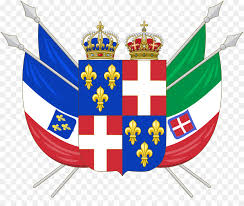
MASCULINE WORDS THAT END IN “MA”: PART II
At times, we encounter some unusual masculine words
because they end in the letter “a”. Here is a list of
masculine nouns that end in “ma” along with their English
translation. Please note that at times the translation is
identical to the original.
| Panama |
Panama |
| panama |
toquilla straw; panama hat |
| panorama |
panorama |
| paradigma |
paradigm |
| patema |
preoccupation, heartache |
| pentagramma |
staff (in music) |
| pigiama |
pajamas |
| plasma |
plasma |
| poema |
epic; epic or symphonic poem |
| politeama |
theatre |
| prisma |
prism |
| problema |
problem |
| proclama |
proclamation |
| programma |
program |
| reuma |
rheumatism |
| scisma |
schism |
| sofisma |
sophism |
| soma |
burden, load (on the back of animals) |
| stemma |
coat of arms, emblem, crest |
| stigma |
stigma |
| stratagemma |
stratagem |
| telegramma |
telegram |
| tema |
theme, topic, essay |
| teorema |
theorem |
| trauma |
trauma |
Saturday, November 17, 2018
|
|
NOTE 
Quando uno studente cerca nel vocabolario per la
traduzione della parola inglese “note”, s’imbatte in
una lunga lista di significati. Esaminiamone alcuni!
Il professore non aveva un testo pronto, solo degli
appunti ai quali è ricorso durante il discorso.
La violinista ha suonato una nota musicale molto dolce.
Hai letto la nota a piè di pagina?
L’ultimo punto che vorrei toccare, è che i prezzi delle
case continuano ad aumentare.
La dottoressa ha scritto un breve articolo
sull’interazione di quelle medicine.
Ti ho detto mille volte di mantenere la chiave, non
puoi migliorare La Traviata.
Questo profumo ha un accento di cannella,
sei d’accordo?
Hai da cambiare una banconota da cento euro?
When a student looks up the translation for the word
“note” in the dictionary she encounters a long list of
meanings. Let’s look at some of them!|
The professor didn't have a prepared text, just notes
that he referred to during the speech.
The violinist played a very sweet musical note.
Did you read the footnote at the bottom of the page?
The last note I would like to make, is that housing
prices continue to rise.
The doctor wrote a brief note on the interaction of
those medicines.
I have told you a thousand times to stick to the notes,
you cannot improve La Traviata.
This perfume has cinnamon notes, do you agree?
Do you have change for a twenty Euro note?
Saturday, November 3, 2018
|
|
| |
NOMI MASCHILI IN –MA: PARTE I
Succede a volte d’incontrare delle parole maschili che
sono insolite perché terminano in “a”. Ecco una lista
di nomi maschili che terminano, in “ma” accompagnate
dalle loro traduzioni in inglese. Notate che a volte la
traduzione è identica all’originale.
MASCULINE WORDS THAT END IN “MA”: PART I

At times, we encounter some unusual masculine words
because they end in the letter “a”. Here is a list of
masculine nouns that end in “ma” along with their
English translation. Please note that at times the
translation is identical to the original.
| aforisma |
aphorism |
| amalgama |
amalgamation |
| alma |
soul |
aroma
|
aroma |
| assioma |
axiom |
| automa |
automaton |
| carcinoma |
carcinoma |
| carisma |
charisma |
| cataclisma |
cataclysm |
| cinema |
cinema |
| clima |
climate |
| coma |
coma |
| comma |
clause, subsection |
| cromosoma |
chromosome |
| diadema |
chromosome |
| diaframma |
diadem, crown, tiara |
| dilemma |
diaphram |
| diploma |
diploma |
| dogma |
dogma |
| idioma |
language, dialect |
| lama |
blade; llama |
| lemma |
word, term, definition |
| marasma |
marasmus, wasting away |
| miasma |
miasma |
| morfema |
morpheme |
| |
|
Saturday, November 10, 2018
|
|
| |

CREAM = PANNA, CREMA, POMATA? PARTE III
Le settimane passate abbiamo parlato degli usi e dei
significati di PANNA e di CREMA. Adesso tocca a
POMATA, che è entrata a far parte del lessico italiano
nel XVI secolo.
La pomata è una preparazione farmaceutica o
cosmetica di consistenza cremosa a uso esterno nella
cura di malattie della pelle e nel trattamento locale di
punture d’insetti, ustioni, ematomi, ecc. Le pomate
comprendono tipi vari come le creme, i gel, gli
unguenti e le paste.
Secondo pagina 54 di La Repubblica del 16 ottobre
1998 “La pomata etimologicamente deriva dal latino
medievale pomata che è il femminile sostantivo di
pomato dall’antico uso di profumare gli unguenti con
polpa di mede appiole; la voce dal latino medievale è
passata pressoché identica anche al francese
(pommade)…allo spagnolo (pomada) e al tedesco
(pomade).“

CREAM = PANNA, CREMA, POMATA? PART III
For the last week we discussed the uses and
meanings of PANNA and CREMA. Now it POMATA’S
turn. This word entered the Italian lexicon in the
16th century.
“Pomata” is a pharmacologic or cosmetic preparation
of a creamy consistency for external use to cure
diseases of the skin and for the treatment of localized
insect bites, burns, bruises, etc. “Pomate” come in
various forms like creams, gels, unguents, ointments,
and salves.
According to page 54 of the October 16, 1998 edition
of the newspaper La Repubblica “The etymological
derivation of pomata is from medieval Latin ‘pomata’
which is the feminine noun of ‘pomato’ from the
ancient use of perfuming unguents with the pulp of
apiole apples; the medieval Latin term has passed
practically identically even into French, Spanish and
German.”
Saturday, October 27, 2018
|
|
| |
CREAM = PANNA, CREMA, POMATA? PARTE II
La settimana scorsa abbiamo parlato degli usi e dei
significati di PANNA. Adesso tocca a CREMA, che è
entrata a far parte del lessico italiano nel XVI secolo.
1. La crema è la parte densa del latte, detta anche
panna, usata per fare il burro.
2. È una vivanda a base di tuorli d’uovo sbattuti,
zucchero e latte amalgamati e cotta sulla fiamma a
bagnomaria.
3. Un liquore molto zuccherato di consistenza pastosa,
per esempio crema cacao o crema di banana.
4. Un passato di verdure, di legumi, di pomodoro, a
volte con l’aggiunta di brodo o farina, usato come
minestra, per esempio di asparagi, di patate, ecc.

5. Qualsiasi sostanza densa, pastosa e untuosa a uso
cosmetico, per esempio crema per le mani, crema da
barba, crema depilatoria, ecc.
6. Crema per calzature, per lucidare le scarpe.
7. In senso figurativo si parla delle persone migliori, il
fior fiore della nobiltà, la crema dell’aristocrazia, della
città, ecc.
8. È anche in funzione di aggettivo invariabile, è il
colore tra il bianco, il giallo e l’avorio.
CREAM = PANNA, CREMA, POMATA? PART II
Last week we discussed the uses and meanings of
PANNA. Now it CREMA’s turn. This word entered the
Italian lexicon in the 16th century.
1. Crema is the dense milk layer, similar to “panna”
used to make butter.
2. It is a food made from beaten egg yolks, sugar and
milk mixed together and cooked over heat in a double
-boiler.
3. A highly-sweetened thick liqueur, for example
Crème de cacao or Crème de banana.
4. A puree made from vegetables, legumes or
tomatoes, at times with the addition of broth or flour,
used as a soup, for example: cream of asparagus, or
cream of potato, etc.
5. Any sense, thick and greasy substance for use in
cosmetics, for example: hand cream, shaving cream,
depilatory cream, etc.

6. Cream used to shine shoes.
7. In a figurative sense, it is used to describe the best
people, the nobility, the cream of the crop of the
aristocracy, of the city, etc.
8. It also functions as an invariable adjective to
describe a color between white, yellow and ivory.
Saturday, October 20, 2018
|
|
| |
CREAM = PANNA, CREMA, POMATA? PARTE I
Se una persona va a cercare la traduzione della parola
“CREAM” nel vocabolario, è presentata con varie
possibilità: panna, crema, e pomata.

Una settimana alla volta parleremo degli usi e dei
significati di ciascuna parola, cominciando con PANNA.
Questa parola è entrata a far parte del lessico italiano
nel XIV secolo.
1. La panna è la parte più grassa del latte che affiora e
si addensa sulla superficie quando il latte è lasciato a
riposo.
2. Quando la panna è sbattuta con una frusta a mano o
un frullatore elettrico aumenta di volume e assume la
consistenza di una schiuma densa; questa è la panna
montata usata nella preparazione e decorazione di
molti dolci o aggiunta a bevande calde.
3. È la superficie o la pellicola del latte che si forma
dopo la bollitura.
4. Attenti però, nel linguaggio marinaresco descrive la
posizione di arresto in mare di una barca a vela
ottenuta attraverso una disposizione di vele o la
mancanza di vento. Esempio: Ieri non tirava un filo di
vento e la nostra barca è rimasta in panna per più di
due ore. I marinai messo la barca in panna per
fermarla.
5. Sempre nel mondo marinaresco, la panna descrive
un’ostruzione volontariamente costruita per limitare
l’accesso a un bacino marittimo.
6. E finalmente, in meccanica, significa una
macchina che non funziona. Esempio: La loro
automobile era in panna, perciò hanno dovuto
chiamare un carro attrezzi.
CREAM = PANNA, CREMA, POMATA? PART I
If an individual looks for the translation of the word
“cream” in the dictionary, they will find various
possibilities:
A week at a time, we will discuss the uses and
meanings of each word, let’s start with PANNA. This
word entered the Italian lexicon in the 14th century.
1. Cream is the fattiest part of milk that rises and
thickens on the surface of milk when it is left
untouched.
2. When cream is shipped with a whisk or an electric
mixer it increases in volume and has the consistency of
dense foam; this is whipped cream used in the
preparation and decoration of many cakes or it is
added to hot drinks.
3. It is the surface or film that forms on the top of
milk after it is boiled.
4. Be careful, because in sailing terms, “panna”
describes the position of the sails at sea to stop a
sailboat or the result of a lack of wind. For example:
Yesterday there wasn’t any wind and our boat didn’t
move for two hours. The sailors heaved the boat in

order to stop her forward progress.
5. Sticking with the topic of the sea, “panna” describes
an obstruction build by choice in order to restrict
access to a lagoon or other body of water.
And finally, in mechanics, it means a car that doesn’t
run. For example: Their automobile was in “panna”,
so they had to call a tow truck.
Saturday, October 13, 2018
|
|

LA BOTTA può essere un’esplosione ma è molto più
comune al maschile, IL BOTTO: Durante la Seconda
Guerra Mondiale, i cittadini del villaggio sentirono un
forte botto durante la notte, e quando si alzarono dal
letto e uscirono in piazza, videro che una bomba aveva
distrutto la loro parrocchia.
L’incidente stradale: Mamma mia che botto! Il
vecchietto non ha visto il semaforo, ha attraversato
l’incrocio col rosso.
In senso colloquiale o a volte volgare significa molto, un
sacco: Ha pagato un botto di soldi per quel quadro, ma
era falso.
E al plurale, sono i fuochi d’artificio: Al paese mio, per la
festa del nostro santo patrono, si tirano botti.
WHAT IS THE DIFFERENCE AMONG THE FOLLOWING:
LA BOTTE, LE BOTTE, LA BOTTA AND IL BOTTO?
Part II
In addition to those listed last week, there are other
meanings:
LA BOTTA can be an explosion; however it is more
common in the masculine,IL BOTTO: During the Second
World War, the citizens of the village heard a loud
explosion during the night, and when they got out of
bed and went into the square, the saw that a bomb had
destroyed their parish church.
A car accident, a pile-up: My goodness what a crash!
The old man didn’t see the traffic signal, and he crossed
the intersection on a red light.
In a colloquial or vulgar sense it means a lot: He paid a
pile of money for that painting, but it was a fake.
In the plural form, they are fireworks: In my town, for
the feast of our patron saint, we throw firecrackers.
Saturday, October 6, 2018
|
|
| |
QUAL È LA DIFFERENZA TRA LA BOTTE,
LE BOTTE, LA BOTTA E IL BOTTO?
Parte I
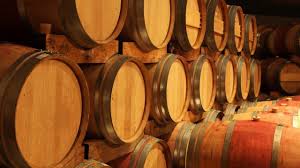
LA BOTTE è un barile: Il vino si stagiona in una botte
di quercia francese o americana. È anche il contenuto di
un barile: Dopo aver conseguito la laurea, gli amici
hanno fatto festa e si sono bevuti una botte di birra.
E in senso figurato, descrive una persona tozza: A forza
di mangiare troppi dolci, Irene è diventata una botte.
Descrive anche la volta semicircolare di un edificio:
Anche se fuori moda, l’architetto ha deciso di costruire
una chiesa con una botte gotica.
LA BOTTA è anche un colpo, ma è più comune sentirla
usata al plurale: I delinquenti hanno dato un sacco di
botte al signore anziano prima di derubarlo.
Si trova anche come il segno dopo un urto: Giorgia si è
fatta male, adesso ha una botta livida al braccio.
In senso figurato anche è un guaio o un danno: Hanno
subito una botta finanziaria dopo il crollo della borsa.
WHAT IS THE DIFFERENCE AMONG THE FOLLOWING:
LA BOTTE, LE BOTTE, LA BOTTA AND IL BOTTO?
Part I
A BOTTE: is a barrel: Wine is aged in a barrel of
French or American oak. It is also the contents of a
barrel or keg: After their college graduation, the friends
celebrated and they drank a keg of beer.
In a figurative sense, it describes a stout person: As a
result of eating too many sweets, Irene now is so
chunky she looks like a barrel.
It also describes the semicircular vault of a building:
Even if out of style, the architect decided to build the
church with a gothic-style barrel vault.
LA BOTTA is a punch or a blow, but it is more often
used in the plural: The juvenile delinquents beat up
the old man before robbing him.
It is also found as a sign after an impact: Giorgia hurt
herself, now she has a blackandblue lump on her arm.
In a figurative sense it can be a problem or a setback:
They suffered a financialsetback after the collapse of
the stockmarket.
Saturday, Sept 29, 2018
|
|
| |
A while ago I introduced a five-part series of WINE
VOCABULARY going from Italian to English. With the
grape harvest starting, for those who prefer to go
from English to Italian, here is the list that can prove
useful. Cheers!
Un po’ di tempo fa, ho introdotto una serie a cinque
parti intitolata il VOCABOLARIO DEL VINO, che
andava dall’italiano all’inglese. Adesso, con l’inizio
della vendemmia, per chi preferisce l’opposto, cioè
dall’inglese all’italiano, ecco la lista. Salute!
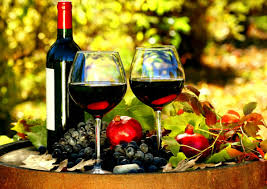
ADDITIONAL WINE VOCABULARY-part IV from
“S” to “Y”:
sand: sabbia
skin: buccia (di una frutta)
slavonian [slovenian]: sloveno
soil: terra o terreno
sort by hand: ordinare; dividere; classificare; scegliere;
selezionare a mano
stainless steel: acciaio inossidabile
stalk: gambo o stelo
stew: stufato o spezzatino
texture: consistenza o apparenza
tonneaux: casks
tortonian calcarcous:
underpinning:
vats: tinozze
venison: carne di cervo
volcanic: vulcanico
well-ventilated: arieggiato, ben ventilato
yeast: lievito
Saturday, Sept 22, 2018
|
|
| |
A while ago I introduced a five-part series of WINE
VOCABULARY going from Italian to English. With the
grape harvest starting, for those who prefer to go
from English to Italian, here is the list that can prove
useful. Cheers!
Un po’ di tempo fa, ho introdotto una serie a cinque
parti intitolata il VOCABOLARIO DEL VINO, che
andava dall’italiano all’inglese. Adesso, con l’inizio
della vendemmia, per chi preferisce l’opposto, cioè
dall’inglese all’italiano, ecco la lista. Salute!

ADDITIONAL WINE VOCABULARY-part III from “M” to “R”:
maceration: macerazione
magnesium: magnesio
malolactic: malolattico
manganese: manganese
mature: stagionato
palate: palato o gusto
phenolic: fenolico
plum: prugna o susina
punching down (regular): appiattire a intervalli regolari
o su base regolare
racking: svinatura
reduce: ridurre
ruby: rubino
Saturday, Sept 15, 2018
|
|
| |
A while ago I introduced a five-part series of WINE
VOCABULARY going from Italian to English. With the
grape harvest starting, for those who prefer to go from
English to Italian, here is the list that can prove useful.
Cheers!
Un po’ di tempo fa, ho introdotto una serie a cinque parti
intitolata il VOCABOLARIO DEL VINO, che andava
dall’italiano all’inglese. Adesso, con l’inizio della
vendemmia, per chi preferisce l’opposto, cioè dall’inglese
all’italiano, ecco la lista. Salute!

ADDITIONAL WINE VOCABULARY-part II from “D” to “L”:
de-stem: rimuovere i gambi da [stem of a wine glass: stelo]
diurnal temperature shift: cambiamento di temperatura
diurno o giornaliero
drainage: drenaggio
elevation: elevazione
eocenic: eocenico
exposure: lato esposto al …
fermented: fermentato
finish: retrogusto
flowering: fioritura
full-bodied: corposo
game: cacciagione o selvaggina
gravel: ghiaia
growing season: stagione di crescita
hand harvested: raccolto/a a mano
harvest: la vendemmia o il raccolto
lamb: agnello (animale); abbacchio (cibo)
limestone: calcare
lush: lussureggiante; gustoso; saporito
Saturday, Sept 8, 2018
|
|
| |
A while ago I introduced a five-part series of WINE
VOCABULARY going from Italian to English. With the
grape harvest starting, for those who prefer to go from
English to Italian, here is the list that can prove useful.
Cheers!
Un po’ di tempo fa, ho introdotto una serie a cinque parti
intitolata il VOCABOLARIO DEL VINO, che andava
dall’italiano all’inglese. Adesso, con l’inizio della
vendemmia, per chi preferisce l’opposto, cioè dall’inglese
all’italiano, ecco la lista. Salute!
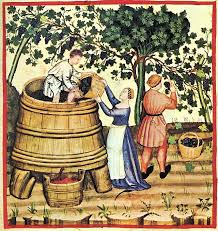
ADDITIONAL WINE VOCABULARY-part I from “A” to “C”:
aged: stagionato
alluring: allettante
auspicious: favorevole; fausto
baked fruit: frutta cotta
berry: bacca (bacche)
blend: miscela o mescolanza
blending of lots: miscela di lotti
boar: cinghiale
botrytis: botrite
braised: brasato
breeze (maritime): brezza marittima
bud: germogliare (verbo); germoglio
bunches: grappoli
capsule or foil: capsula
cask: botte o barile
chalk deposits: depositi di gesso
clay: argilla
cru: annata
crushed: spremute o schiacciate
Saturday, Sept 1, 2018
|
| |
|

Adesso tocca a voi di trovare la canzone su YouTube e
cantarla a squarciagola. Se volete praticare il vostro inglese,
lascio la traduzione a voi, è un buon ripasso dei verbi
all’infinito. Buon divertimento!
NEL BLU DIPINTO DI BLU (VOLARE) Domenico Modugno
Penso che un sogno così non ritorni mai più
Mi dipingevo le mani e la faccia di blu
Poi d'improvviso venivo dal vento rapito
E incominciavo a volare nel cielo infinito
Volare oh, oh
Cantare oh, oh
Nel blu dipinto di blu
Felice di stare lassù
E volavo, volavo felice più in alto del sole
Ed ancora più su
Mentre il mondo pian piano spariva lontano laggiù
Una musica dolce suonava soltanto per me
Volare oh, oh
Cantare oh, oh
Nel blu dipinto di blu
Felice di stare lassù
Ma tutti i sogni nell'alba svaniscon’ perché
Quando tramonta la luna li porta con sé
Ma io continuo a sognare negli occhi tuoi belli
Che sono blu come un cielo trapunto di stelle
Volare oh, oh
Cantare oh, oh
Nel blu degli occhi tuoi blu
Felice di stare quaggiù
E continuo a volare felice più in alto del sole
Ed ancora più su
Mentre il mondo pian piano scompare negli occhi tuoi blu
La tua voce è una musica dolce che suona per me
Volare oh, oh
Cantare oh, oh
Nel blu degli occhi tuoi blu
Felice di stare quaggiù
Nel blu degli occhi tuoi blu
Felice di stare quaggiù
Con te
Songwriters: Domenico Modugno / Francesco Migliacci
Nel blu dipinto di blu (Volare) lyrics © Downtown Music
Publishing
Now it’s your turn to find the song on YouTube and sing
along at full volume.
I will also leave the translation of the lyrics up to you; it’s
a good exercise in verbs in the infinitive.
Have fun!
Saturday, Aug 25, 2018
|
|
| |
Nel blu dipinto di blu, o Volare
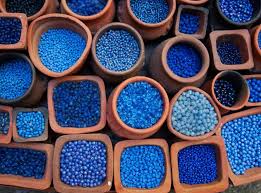 è la famosa canzone scritta è la famosa canzone scritta
da Franco Migliacci e Domenico Modugno che vinse 8°
festival di San Remo nel 1958. L’anno seguente fu la prima
canzone a vincere il premio Grammy per Disco dell’anno e
Canzone dell’anno. Ma di quale blu parliamo? Ecco una bella
lista:
Acqua
Acquamarina
Avio
Azzurro
Azzurro fiordaliso
Azzurro pastello
Blu acciaio
Blu alice
Blu Bondi
Blu chiaro
Blu di Persia
Blu di Prussia
Blu Dodger
Blu egiziano
Blu elettrico
Blu fiordaliso
Blu marino
Blu notte
Blu oltremare
Blu pavone
Blu polvere
Blu reale
Blu Savoia
Blu scuro
Blu Tiffany
Carta da zucchero
Celeste
Ceruleo
Ciano
Cobalto
Denim
Blu cadetto
Indaco
International Klein Blue
Lavanda
Pervinca
YInMn Blu
Zaffiro

Nel blu dipinto di blu more popularly known as Volare in the
United States is the famous song written by Franco Migliacci
and Domenico Modugno that won the 8th Music Festival of
San Remo in 1958. The following year, it was the first song
to win a Grammy for both Record of the Year and Song of
the Year.
But which blue are we talking about? Here is a nice list:
| Water |
Egyptian blue |
Sky blue |
| Aquamarine |
Electric blue |
Cerulean |
| Airman blue |
Cornflower blue |
Ciano |
| Azure |
Sea blue |
Cobalt |
| Cornflower pale blue |
Night blue |
Denim |
| Pastel azure |
Ultramarine |
Cadet blue |
| Steel blue |
Peacock blue |
Indigo |
| Anchovy blue |
Dusty blue |
International
Klein Blue |
| Biondi blue |
Royal blue |
Lavender |
| Light blue |
Savoy Blue |
Periwinkle |
| Persian blue |
Dark blue |
YinMn Blue |
| Prussian blue |
Tiffany blue |
Sapphire |
| Dodger blue |
Sugar paper |
|
Saturday, Aug 18, 2018
|
|
| |
FERRAGOSTO IN CUCINA ATTRAVERSO L’ITALIA.
Ho trovato questa lista in internet. Buon appetito e buon
divertimento.
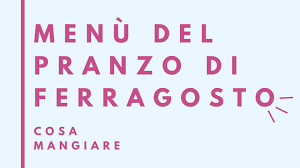
Il piatto tradizionale per eccellenza del pranzo di Ferragosto è il
piccione arrostito. Tale usanza, un tempo diffusa in buona parte
d'Italia e che ancora sopravvive in alcune zone, pare sia nata in
Toscana, in epoca carolingia. [Attilio Zuccagni-Orlandini,
Corografia fisica, storica e statistica dell'Italia e delle sue isole,
Presso gli Editori, Firenze, 1842]
· L'antica tradizione piacentina prevede la preparazione della
bomba di riso con piccioni, una sorta di grosso cilindro di riso
cotto al forno, con pezzi di piccione all'interno. [Andrea Mazzanti,
La Cucina Regionale Italiana, Venezia, Mazzanti Libri,
2014]
· In Sicilia si usa preparare per Ferragosto il tipico gelu di muluna,
decorato con foglie di limone e fiori di gelsomino.[ Annalisa
Barbagli, La cucina di casa del Gambero Rosso, GRH, 2002]
· A Roma il piatto tradizionale del pranzo di Ferragosto è
costituito dal pollo in umido con peperoni, spesso preceduto dalle
fettuccine ai fegatelli e seguito da cocomero ben freddo. [Alberto
Sordi, E a Ferragosto mangiate con me ... se ce la fate, La Stampa,
12 agosto 1988]
· In Puglia il piatto tipico di Ferragosto è costituito dal galluccio,
un gallo di circa 3 kg ripieno, cotto al forno con patate. [Il
Galluccio, storia e ricetta del piatto tradizionale foggiano di
Ferragosto, Foggia Today, 14 luglio 2015]
· Le Margheritine di Stresa sono i biscotti che venivano
tradizionalmente offerti agli ospiti dalla regina Margherita, in
occasione dei ricevimenti di Ferragosto della Casa Reale. [AAVV,
Laghi italiani - Guide Lancia, Touring Club Editore, Milano, 2001,
pag.88]
· Sull'Appennino tosco-emiliano, per Ferragosto è costumanza
sfornare e consumare piccole ciambelle dolci all'anice, variamente
confezionate, come il Biscotto di mezz'agosto di Pitigliano o lo
Zuccherino montanaro bolognese di Grizzana Morandi.[AAVV,
L'Italia dei dolci, Touring Club Editore, Milano, 2004, pag.82-85]
AUGUST 15TH/FERRAGOSTO IN THE KITCHEN THROUGHOUT
ITALY.
I found this list on the internet. Enjoy and have fun.
· The traditional dish for Ferragosto, aka August 15th, dinner is
roasted pigeon. This custom, at one time found throughout most
of Italy, and still is present in certain areas, seems to have
originated inTuscany during the Carolingian period.
· The ancient tradition from Piacenza calls for the preparation of
the ‘rice bomb’ with pigeon; it’s a type of large cylinder of rice
baked in the oven with bits of pigeon inside.
· In Sicily the typical dish is gelu di mulunadecorated with lemon
leaves and jasmine.
· In Rome, the traditional Ferragosto meal is composed of
chicken with peppers stewed in the oven, often preceded by
fettuccine with chicken livers and followed byvery cold
watermelon.
· In Puglia, the typical dish is a rooster weighing about 6 ½
pounds stuffed, and oven-baked with potatoes.
· In Stresa, ‘Little Daises’ are cookies which were traditionally
offered to the guests of the queen Margherita during receptions
held at the Royal Palace on August 15th.
· On the Tuscan-Emilian Apennines the custom is to bake and eat
little sweet anise-flavored donuts made in different ways
depending on the area.
[For source materials on this information please see above.]
Saturday, Aug 11, 2018
|
|
| |

Iniziamo il mese di agosto con una poesia di Gianni Rodari:
La filastrocca sul Ferragosto.
«Filastrocca vola e va
dal bambino rimasto in città.
Chi va al mare ha vita serena
e fa i castelli con la rena,
chi va ai monti fa le scalate
e prende la doccia alle cascate…
E chi quattrini non ne ha?
Solo, solo resta in città:
si sdrai al sole sul marciapiede,
se non c’è un vigile che lo vede,
e i suoi battelli sottomarini
fanno vela nei tombini.
Quando divento Presidente
faccio un decreto a tutta la gente;
“Ordinanza numero uno:
in città non resta nessuno;
ordinanza che viene poi,
tutti al mare, paghiamo noi,
inoltre le Alpi e gli Appennini
sono donati a tutti i bambini.
Chi non rispetta il decretato
va in prigione difilato».
Da Filastrocche in Cielo e in Terra, Torino, Einaudi,
1960
Gianni Rodari, all'anagrafe Giovanni Rodari
(Omegna/Lago d’Orta/Piemonte, 23 ottobre 1920 –
Roma, 14 aprile 1980), è stato uno scrittore,
pedagogista, giornalista e poeta italiano, specializzato
in letteratura per l'infanzia e tradotto in molte lingue. Unico
vincitore italiano del prestigioso Premio Hans Christian
Andersen nel 1970 fu uno fra i maggiori interpreti del tema
"fantastico" nonché, grazie alla Grammatica della fantasia del
1973, sua opera principale, uno fra i principali teorici dell'arte
di inventare storie.

Let’s begin the month of August with a poem by Gianni
Rodari: The nursery rhyme about August 15th.
Nursery rhyme, fly and go
to the child left in the city.
The one who goes to the seaside has a serene life building
castles in the sand, The one who goes to the mountains,
climbs them and takes a shower in the waterfalls…And for the
one who doesn’t have money? That one remains all alone in
the city: to lay down in the sunshine on the sidewalk,
if there isn’t a policeman to see him,
and his submarines
go sailing in the manholes.
When I become President
I will order everyone;
“Law number one:
no one remains in the city;
the law that follows,
everyone goes to the seashore; we pay!
In addition the Alps and the Apennines
are given to all the children.
Whoever doesn’t follow the orders
goes directly to jail”.
From: Filastrocche in Cielo e in Terra, Torino, Einaudi, 1960
(my translation)
Gianni Rodari, born Giovanni Rodari
(Omegena/Lake d’Orta/Piedmont, 23 October 1920 – Rome,
14 April 1980) was an Italian writer, educationalist, journalist
and poet. He is most famous for his children's books, notably
Il romanzo di Cipollino. For his lasting contribution as a
children's writer he is the only Italian writer to be awarded, in
1970, the Hans Christian Andersen Medal. In addition to his
literature for children he wrote Grammar of Fantasyin 1973,
which some consider his major work, it is one of the principal
theoretical works on the art of inventing stories.
Saturday, Aug 4, 2018
|
| |
|
Shopping  
Ci sono vari modi di esprimere questa parola in italiano:
1. Fare la spesa (al singolare): le compere che si fanno più o meno ogni
giorno per generi alimentari o prodotti di uso domestico: dalla
fruttivendola, dal macellaio, dal fornaio, ecc. In altre parole, sono gli
acquisti nei negozi vicino a casa, al supermercato, o alle bancarelle del
mercato in piazza.
2. Fare le spese (al plurale): le compere, gli acquisti, o lo shopping per
altri prodotti: i vestiti, le scarpe, ecc.
Così possiamo dire: Quando ero piccola in Italia, ogni mattina mia
madre andava fuori a fare la spesa per quello che avremmo mangiato a
pranzo e cena quel giorno. Prima dell’inizio dell’anno scolastico però,
mia madre mi portava ai negozi del centro per fare le spese per la
divisa che dovevo indossare a scuola.
There are various ways to translate this word in Italian:
1. In the singular (fare la spesa): refers to the things that are
purchased more or less every day, food stuffs or items for domestic
use: from the green grocer, the butcher, the baker, etc. In other words,
the purchases from stores near home, the supermarket, or the stands
from the farmers’ market in the square.
2. In the plural (fare le spese): the purchases, the shopping for other
items: clothing, shoes, etc. Note that Italian has several terms for this
concept.
Therefore we can say: When I was young in Italy, every morning my
mother went out to do the shopping (fare la spesa) for the items we
would eat at lunch and dinner that day. Before the beginning of the
school year however, my mother would take me downtown to shop
(fare le spese) for the uniform I had to wear to school.
Saturday, July 28, 2018
|
|
| |
TEMPLI O TEMPI?
Perché il plurale di tempio è templi e non tempi secondo le regole di
grammatica per il plurale di parole maschili che terminano in “o”?
La forma corretta del plurale di tempio, infatti, è templi, che deriva dal
latino templum. A volte si vede la forma tempi, ma è meno comune e
sconsigliabile perché è uguale al plurale di tempo.
Adesso sarebbe il caso di fare una visita alla Valle
dei Templi ad Agrigento in Sicilia. Buon viaggio!

Why is the plural of the Italian word for temple (tempio) templi and not
tempi as would be normal if following standard pluralization rules of
masculine singular words ending in “o”?
The correct plural form of tempio is in fact, templi which derives from
the Latintemplum.
At times one sees the plural tempi, but it is less common and
inadvisable because it is the same as the plural of tempo (time).
Now would be the time to visit the Valley of the Temples in Agrigento,
Sicily. Have a good trip!
Saturday, July 21, 2018
|
|
| |

Fa caldo in Italia d’estate e avete voglia di una fetta di…ma non sapete se si
dice ANGURIA O COCOMERO? Per una risposta tecnica ci rivolgiamo al
CORRIERE DELLA SERA—DIZIONARIO “SI DICE”
· Si sa che il termine più appropriato, che ripete quello dei botanici, è
cocomero, latino scientifico Cucumis citrullus; e cocomero si dice in tutta
l’Italia centrale, mentre nell’Italia meridionale l’espressione comune è
mellone (o melone) d’acqua, per distinguerlo dal mellone di pane, quello che
tutto il resto d’Italia chiama semplicemente melone, e in Toscana viene
detto anche popone.
· Anguria è un termine più regionale che invade tutto il Settentrione, con
varianti dialettali notevoli. Per confondere ancor di più le idee, ecco che nella
stessa Lombardia e in vari luoghi del Piemonte e perfino del Mezzogiorno,
chiamano cocomero il cetriolo!
· Ritornando all’anguria, il nome risale al tardo greco angurion (che indicava
propriamente il cetriolo), termine venutoci con la dominazione bizantina,
intorno al VI secolo d.C., e diffuso in tutta l’Italia settentrionale attraverso
l’Esarcato di Ravenna. Con referenze storiche così alte, anche anguria ha
dunque pieno diritto di cittadinanza, e possiamo tranquillamente usarlo in
alternativa a cocomero.
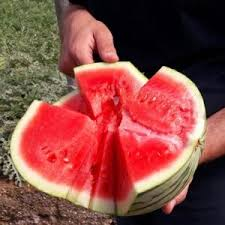 It’s hot in Italy during the summer and you are It’s hot in Italy during the summer and you are
craving a slice of WATERMELON, but what do you ask for since there are two
words that can be used. We turn to the DICTIONARY “HOW IT IS SAID” from
one of the major Italian newspapers, the CORRIERE DELLA SERA.
· The most appropriate term, the one that reiterates the botanical one is
cocomero from the scientific Latin Cucumis citrullus; therefore cocomero is
used throughout central Italy, while in southern Italy the most common
expression is mellone (or melone) d’acqua—watermelon—to differentiate it
from the mellone di pane, that which in the rest of Italy is simply called
melon, while in Tuscany it is called popone.
· Anguria is a more regional term that has invaded all of northern Italy, with
notable dialectical variations. To confuse us further, in Lombardy and in
various parts of Piedmont and even in the South, the word cocomero is used
for cucumber.
· Let’s return to anguria, the name dates back to ancient Greek angurion
(which indeed was a cucumber), a word which came to Italy during Byzantine
domination around the 6th Century BCE, and spread throughout northern Italy
by way of the Territory of Ravenna. With such highbrow references, even
anguria has full rights of citizenship, and we can use it comfortably as an
alternative to cocomero.
Saturday, July 14, 2018
|
|
| |
FAN=TIFOSO!? 
Nell’italiano colloquiale però, esiste anche la voce divertente e scherzosa
FAN, un’abbreviazione di FANATICO, che era già dal 17° secolo in uso in
Inghilterra e ripreso negli Stati Uniti verso l’inizio del 20° secolo per
descrivere gli appassionati di sport, prevalentemente il baseball. Oggi, il
FAN si trova anche in italiano, ma più che descrivere un tifoso di una squadra
sportiva, riferisce a un seguace di qualcuno o qualcosa, per esempio: i fans di
Jerry Garcia e i Grateful Dead; le fans della Ducati; ecc.
There is however another expression in colloquial Italian, “FAN”. This term is
found as early as the 17thcentury in England to describe a “fanatic”. It was
later reintroduced into everyday speech in the United States in the 20th
century to describe a follower of baseball. In Italian, the term is used, both
in the feminine and the masculine, to describe someone who is an admirer, a
fanatic, of someone or something, for example: the fans of Jerry Garcia and
the Grateful Dead; the fans of Ducati motorcycles, etc.
Saturday, July 7, 2018
|
|
| |
 TIFOSO = FAN!? TIFOSO = FAN!?
Il Vocabolario Treccani definisce la parola TIFOSO in questo modo:
<<tifóso agg. [der. di tifo]. – 1. In medicina: a. Di tifo, che ha i caratteri
del tifo: febbre alta a tipo tifoso. In partic., stato t., quadro clinico osservabil
e in diverse sindromi morbose per lo più di natura infettiva, caratterizzato da
febbre elevata, offuscamento della coscienza, sempre più o meno profondo,
adinamia, prostrazione, delirio, disturbi sensoriali. b. Ammalato di tifo, anche
come sost.: la sintomatologia caratteristica dei tifosi. 2. fig. Entusiasta,
appassionato per un genere di sport, acceso sostenitore di una squadra
sportiva o di un atleta: gli spettatori più tifosi; spesso sostantivato: i t. della
squadra locale; essere un t. del pugilato (o di un pugile). Per estens., che, o
chi, manifesta entusiasmo e viva, talora fanatica, ammirazione per attori,
cantanti o altre persone di grande notorietà, spec. nel mondo dell’arte e dello
spettacolo. >>
Where does the Italian term for fan (not what we use on a hot summer day
to cool down) come from? The Treccani Dictionary defines it thus:
“Tifoso adjective [derived from tifo] 1. In medicine: a. pertaining to typhus,
characteristics of typhus: high typhus-type fever. In a particular typhus state,
a medical case with varied pathological syndromes mostly of an infectious
nature, characterized by high fever, obfuscation of awareness, more or less
deep, adynamia, prostration, delirium, sensory ailments;b. Ill with typhus,
also used as a noun: the characteristic symptomology of a typhus sufferer.
2. Figurative. Enthusiast, aficionado of a sport, a strong supporter of a sports
team or an athlete: the most fanatical spectators; often a noun: the fans of
the local team; to be a boxing fan (or of a boxer). By extension, someone or
something who manifests enthusiasm and strong, at times fanatical, admirati
on for actors, singers or other famous people, especially in the world of art or
show business.”
Saturday, June 30, 2018
|
| |
|
LA COPPA DEL MONDO è in pieno svolgimento di nuovo, vale le la pena
ripassare il vocabolalrio che ho presentato quattro anni fa.
THE WORLD CUP is in full swing again, let’s revisit the vocabulary which I
introduced four years ago.
Abbigliamento—attire:
i calzoncini—shorts
i calzini (le calze da giocatore)—socks
i guanti da portiere—goalkeeper's gloves
la maglia—shirt (jersey)
il parastinchi—shin guards
la scarpa da calcio—soccer shoe
Il campo da gioco—the soccer field:
l'arbitro—referee
l'area di rigore—penalty area
la bandierina di calcio d'angolo—corner flag
il campo di calcio—field
il guardalinee—linesman
la linea di fondo—goal line
la linea di metà campo—half-way line
la linea laterale—touch line
il palo (il palo della porta)—post (goalpost)
la rete—the net
lo stadio—stadium
la traversa—crossbar
I giocatori e la squadra—the players and the field:
l'ala—outside forward (winger)
l'allenatore—coach
l'allenatore in secondo—assistant coach
l'attaccante—striker
il centravanti—center forward
il centrocampista—midfield player
il commissario tecnico (CT)—head coach of the Italian National Team
il difensore—defender
il difensore esterno—outside defender
il libero—sweeper
il mediano—midfielder
la mezz'ala—inside forward (striker)
il Mister (un altro termine per CT)—another term for head coach of the
Italian National Team
il portiere—goalkeeper
la riserva (il giocatore di reserva)—substitute
lo stopper—inside defender
terzino destro/sinistro—right/left back
La partita—the game:
l'ammonizione—warning
l'arresto (della palla)—receiving the ball (taking a pass)
il calcio d'angolo (il corner)—corner (corner kick)
il calcio di punizione—free kick
il calcio di rigore (il rigore)—penalty (penalty kick)
il calcio di rinvio—goal kick
il cartellino giallo (per l'ammonizione)—yellow card (as a caution)
il cartellino rosso (per l'espulsione)—red card (for expulsion)
il cerchietto del calcio di rigore—penalty spot
il colpo di testa—header
il dribbling—dribble
il fallo—foul
fare la melina—waste time by passing the ball back and forth
il fuorigioco—offside
il gol o la rete—goal
il passaggio diretto (della palla)—pass (passing the ball)
il passaggio corto—short pass
la respinta di pugno—save with the fists
la rimessa laterale—throw-in
la rovesciata—bicycle kick
segnare un gol—to score a goal

Saturday, June 23, 2018
|
| |
|
ACCADEMIA DELLA CRUSCA
Spesso mi rivolgo all’Accademia della Crusca per chiarificazioni e spiegazioni,
ma mi domando se la conoscete. La spiegazione bilingue che segue è tratta
dal loro sito web e serve da punto di riferimento:
http://www.accademiadellacrusca.it/en.
In Italia e nel mondo l'Accademia della Crusca è uno dei principali punti di
riferimento per le ricerche sulla lingua italiana.La sua attività presente punta
ai seguenti obiettivi:
sostenere, attraverso i suoi Centri specializzati e in rapporto di collaborazione
e integrazione con le Università, l'attività scientifica e la formazione di nuovi
ricercatori nel campo della linguistica e della filologia italiana;
acquisire e diffondere, nella società italiana e in particolare nella scuola, la
conoscenza storica della nostra lingua e la coscienza critica della sua
evoluzione attuale, nel quadro degli scambi interlinguistici del mondo
contemporaneo;
collaborare con le principali istituzioni affini di Paesi esteri e con le istituzioni
governative italiane e dell'Unione Europea per la politica a favore del
plurilinguismo del nostro continente.
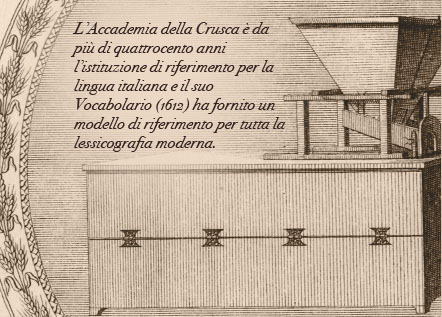
L'Accademia della Crusca è sorta a Firenze tra il 1582 e il 1583, per iniziativa
di cinque letterati fiorentini (Giovan Battista Deti, Anton Francesco Grazzini,
Bernardo Canigiani, Bernardo Zanchini, Bastiano de' Rossi) ai quali si
aggiunse subito Lionardo Salviati, ideatore di un vero programma culturale e
di codificazione della lingua. Dalle loro animate riunioni, chiamate
scherzosamente "cruscate", derivò il nome di "Accademia della Crusca", vòlto
poi a significare il lavoro di ripulitura della lingua. L'istituzione assunse come
proprio motto un verso del Petrarca - "il più bel fior ne coglie" - e adottò una
ricca simbologia tutta riferita al grano e al pane.
Fin dall'inizio l'Accademia ha accolto studiosi ed esponenti, italiani ed esteri,
di diversi campi: oltre a grammatici e filologi, scrittori e poeti (Tassoni,
Maffei, Maggi, Monti, Leopardi, Manzoni, Carducci, ecc.), scienziati (Galilei,
Redi, Torricelli, Malpighi), storici (Muratori, Botta, Capponi), filosofi (Voltaire,
Rosmini), giuristi e statisti (Witte, Gladstone).
L'opera principale dell'Accademia, il Vocabolario (1612; ampliato e
ripubblicato più volte fino al 1923), pur sottoposta ad attacchi per i limiti che
poneva all'uso linguistico vivo, ha dato un contributo decisivo
all'identificazione e alla diffusione della lingua italiana e ha fornito l'esempio
ai grandi lessici delle lingue francese, spagnola, tedesca e inglese.
Il nuovo progetto del Vocabolario, elaborato e avviato dall'Accademia negli
anni 1955-1985, ha finalità esclusivamente di documentazione storica ed è
una delle maggiori imprese lessicografiche europee. Viene ora realizzato dall
'Opera del Vocabolario Italiano, Istituto del CNR affiancato all'Accademia,
affidato nel 1992 alla direzione di Pietro G. Beltrami. Dal 1° ottobre 2014,
Lino Leonardi è il nuovo direttore dell'OVI.
~~~~~~~~~~~~~~~~~~~~~~~~~~~~~~~~~~~~~~
ACCADEMIA DELLA CRUSCA
I often refer to the Accademia della Crusta for clarifications and e
explanations, but I ask myself if you know what it is. The bilingual
explanation that follows comes from their website and is a reference point:
http://www.accademiadellacrusca.it/en.
In both Italy and worldwide, the Accademia della Crusca is among the
leading institutions in the field of research on the Italian language. At
present its activity is centered on the following:
supporting scientific activity and the training of new researchers in Italian
linguistics and philology through its Centres and in cooperation with
Universities;
acquiring and spreading, in Italian society as a whole and especially in
schools, historical knowledge of the Italian language and awareness of its
present evolution, in the context of the cross-linguistic exchanges that are so
common in the present world;
collaborating with the most important foreign institutions as well as with
Italian and European Governments, to support the cause of multilingualism on
our continent.
The Accademia della Crusca - literally 'the Bran Academy' - was founded in
Florence between 1582 and 1583 on the initiative of five Florentine men of
letters. One of them was Lionardo Salviati, inventor of a complete cultural and
language-coding programme. The name "Accademia della Crusca" was derived
from their lively meetings, playfully called "cruscate" ('bran-meetings'), and
came to signify the work of 'cleaning up' the language (the bran is the part of
the wheat that is discarded when the grain is cleaned up). The newly founded
institution adopted as its motto a line from a poem by Francesco Petrarca: "il
più bel fior ne coglie" ('she picks the fairest flower') and built up a rich
symbology based on wheat and bread.
From the beginning the Accademia welcomed Italian and foreign scholars of
various fields of interest: besides grammaticians and philologists, writers and
poets (Tassoni, Maffei, Maggi, Monti, Leopardi, Manzoni, Carducci, ecc.),
scientists (Galilei, Redi, Torricelli, Malpighi), historians (Muratori, Botta,
Capponi), philosophers, (Voltaire, Rosmini), jurists and statesmen (Witte,
Gladstone).
The main accomplishment of the Accademia, the Vocabolario (i.e. Dictionary,
dated 1612, reprinted and enlarged several times until 1923), though subject
to criticism for the limits it imposed on living linguistic usage, has made an
exceptional contribution to the identification and diffusion of the Italian
language and has served as an example for the great dictionaries of French,
Spanish, German and English.
The new Vocabolario project, developed and started by the Accademia
between 1955 and 1985, has the sole purpose of carrying out historical
documentation and is one of the major lexicographic enterprises in Europe.
The project is now the work of the Opera del Vocabolario Italiano, an
Institute of the CNR (Consiglio Nazionale delle Ricerche i.e. 'National Council
for Research'), affiliated to the Accademia and directed by Pietro G. Beltrami.
The current director of the OVI is Lino Leonardi.
Saturday, June 16, 2018
|
| |
|
HOW DO YOU SAY “SHEETS” IN ITALIAN? LENZUOLI O LENZUOLA?
A volte la grammatica è proprio ridicola. Vi do un esempio: Avete mai cercato
di spiegare a una persona che sta imparando l’italiano, la differenza tra
lenzuoli e lenzuola?
La parola lenzuolo ha due plurali con significati diversi:
- Il plurale maschile lenzuoli descrive più di un lenzuolo ma considerati
singolarmente.
Per esempio: Quando ho aperto l’armadio della biancheria, mi sono
accorta che avevo due lenzuoli di colori diversi. Era un guaio perché
venivano ospiti e volevo fare bella figura.

- Il plurale femminile lenzuola descrive le due lenzuola, una coppia che si
usa per preparare il letto.
Per esempio: Per il mio letto matrimoniale preferisco le lenzuola
colorate di puro cotone, quelle bianche mi ricordano un albergo.
At times grammar is completely ridiculous. I’ll give you an example:
Have you ever tried to explain to someone who is studying Italian why
there are two ways of saying the plural of sheet in Italian.
The word sheet has two plural forms with different meanings:
- The masculine plural lenzuoli (sheets) describes more than one
sheet, but considered individually.
For example: When I opened the linen closet, I realized that I only
had two lenzuoli (sheets) of different colors. It was a problem
because I had guests coming and I wanted to make a good
impression.
- The feminine plural lenzuola (sheets) describes a matched set of
bed sheets.
For example: For my king-size bed I prefer colored lenzuola
(sheets) of pure cotton, white ones remind me of a hotel.
|
| |
|
| |
Saturday, June 9, 2018 |
|
|
| |
La FESTA DELLA REPUBBLICA ITALIANA, celebrata il 2 giugno di ogni
anno, è la principale festa nazionale civile italiana che ricorda la nascita della
Repubblica italiana. Questa “nascita” avvenne a seguito dei risultati del
referendum istituzionale del 2 e 3 giugno 1946, indetto per determinare la
forma di governo da dare all'Italia dopo la seconda guerra mondiale.
Per la prima volta in una consultazione politica nazionale votavano anche le
donne: risultarono votanti circa 13 milioni di donne e circa 12 milioni di uomini,
pari complessivamente all'89,08% degli allora 28.005.449 aventi diritto al voto.
I risultati furono proclamati dalla Corte di cassazione il 10 giugno 1946 e
riportati nella Gazzetta Ufficiale della Repubblica Italiana, Anno 87° Numero
134: 12.717.923 cittadini favorevoli alla repubblica e 10.719.284 cittadini
favorevoli alla monarchia e 1.498.136 nulli.
Secondo me, la cartina qui riportata dimostra una divisione abbastanza forte
tra i sostenitori della repubblica e quelli della monarchia. È cambiata molto
l’Italia in questi 62 anni? Traete le vostre conclusioni!

FESTA DELLA REPUBBLICA (The Day of the Founding of the Italian
Republic), celebrated on June 2nd each year, is the most important National
Civil Holiday in Italy; it commemorates the birth of the Republic of Italy. This
“birth” took place after a national referendum was held June 2 and 3, 1946 in
order to determine the form of government to adopt in post-World War II Italy.
For the first time women were given the right to vote; approximately 13 million
women and 12 million men, went to the polls, in total slightly over 89% of the
then 28,005,449 individuals having the right to vote.
The results were proclaimed by the Court of Cassation on June 10, 1946 and
published in the Official Gazette of the Republic of Italy, Year 87° Number
134 12,717,923 votes for a republic and 10,719,284 for the monarchy, with
1,498,136 considered null.
In my opinion, the map reveals a rather strong division between those in favor
of the republic and those in favor of the monarchy. Has there been much
change in Italy in the past 62 years? You draw your own conclusions!
Saturday, June 2, 2018
|
|
| |
 POLIZIA DI STATO: POLIZIA DI STATO:
La Polizia di Stato è un’arma civile che dipende direttamente dal Dipartimento
della Pubblica Sicurezza del Ministero dell’Interno. Risale all’Ottocento e si
occupa dell’ordine pubblico. È maggiormente presente nei grandi centri urbani,
rispetto ai piccoli. Le attività svolte sono molteplici: il mantenimento
dell’ordine durante manifestazioni (politiche, musicali, sportive) di qualsiasi
genere, il controllo delle strade e autostrade, il controllo delle carceri, la
sicurezza sui treni e negli aeroporti. Per le ragioni summenzionate, esistono
diversi tipi d’istituzioni, ognuna con un compito dedicato: Polizie di Stato:
Ferroviaria, Penitenziaria, Stradale, Municipale e Postale.
I ruoli ricoperti all’interno della Polizia di Stato sono agenti, assistenti,
sovrintendenti, ispettori, funzionari e dirigenti. La Polizia di Stato indossa una
divisa grigio-azzurra con bande di colore bordò.
 THE STATE POLICE: THE STATE POLICE:
The Italian State Police is a civilian corps that works directly under the
Department of Public Safety of the Ministry of the Interior. It dates back to
the 1800’s and deals with public order. Its major presence is in large urban
centers, rather than smaller ones. Its activities are varied: maintaining order
during all kinds of demonstrations (political, musical, sports), supervising
roads and highways, prisons, on trains and at airports. For these reasons,
there are different kinds of institutions, each with its own duties: State Police,
Railway Police; Prison Guards; Highway Patrol, City Police, and Postal Police.
The duties within the State Police are: agents, assistants, superintendents,
inspectors, functionaries and directors. The State Police wears a gray-blue
uniform with a Bordeaux-colored stripe.
Saturday, May 26, 2018
|
|
| |
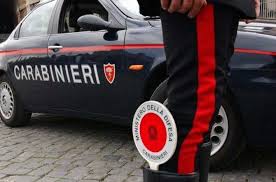 I Carabinieri, I Carabinieri,
sono una forza armata che risale al tempo del Regno di Sardegna quando
Vittorio Emanuele I di Savoia, emanò la legge reale del 13 luglio 1814 ("Regie
Patenti") con la quale stabilì il Corpo dei Carabinieri Reali, unità militare con
compiti di polizia.
Oggi, l’Arma dei carabinieri è una forza armata che dipende dal Ministero della
Difesa. Le funzioni svolte dall’Arma dei carabinieri si suddividono in tre
categorie: compiti militari, compiti di polizia e quelli speciali. I Carabinieri
svolgono attività di sicurezza civile, di ordine pubblico e di tipo militare. I
carabinieri possono operare sia come corpo militare svolgendo missioni
all’estero, che come supporto alla polizia locale nell’ambito della sicurezza
civile. I Carabinieri sono presenti principalmente, oltre che nei grandi centri
urbani, anche nei piccoli borghi cittadini e sono il segno della presenza dello
Stato italiano in ogni città e paese.
L’Arma dei carabinieri costituisce una delle quattro forze armate della
Repubblica Italiana; le altre sono l’Esercito Italiano, la Marina Militare e
l’Aeronautica Militare. Inizialmente è nata come arma all’interno dell’Esercito
Italiano, ma nel 2000 è stata dichiarata una forza armata autonoma, anche se
dipendente del Ministero della Difesa. Il 2000 ha visto l’arruolamento nei
Carabinieri (che in precedenza era solo aperto agli uomini) esteso anche alle
donne. I gradi dei Carabinierisi dividono in: Appuntati, Brigadieri, Marescialli e
Ufficiali. Le divise sono di colore nero con bande rosse.
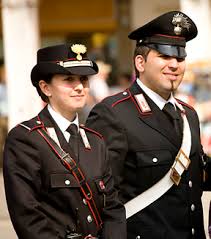
The CARABINIERI are a corps that dates back to the time of the Kingdom of
Sardinia when Victor Emmanuel I of Savoy issued a royal decree on July 13,
1814 establishing the Royal Corps of the Carabinieri, a military organization
with police duties.
Today, this corps depends on the Ministry of Defense. Its duties are divided
in three categories: military, police, and special duties. The Carabinieri can
function both as a military branch, even with duties abroad, as well as support
for local police in the sector of public safety. The Carabinieri are a presence
in small towns as well as in large cities and represent the presence of the
Italian state in every city and town.
The Carabinieri is one of the four branches of the armed forces of the Republic
of Italy, the others are the Army, the Navy and the Air Force. At first, it was
constituted as a corps within the Army, but in 2000 it became an autonomous
force, even if still within the Ministry of Defense. 2000 also witnessed the
enlistment of women—prior to this date the Carabinieri were only open to men.
The Carabinieri ranks are divided in: “appointed”, brigadier, marshal and
officer. Their uniforms are black with a red stripe.
Saturday, May 19, 2018
|
|
| |
Si dice vigile del fuoco o pompiere?
Il Corpo nazionale dei vigili del fuoco (in acronimo CNVVF ed abbreviato VV.
F.) fu istituito con regio decreto il 27 febbraio 1939. Oggi è un corpo civile
della Repubblica d’Italia , dipendente dal Ministero dell'interno. Fa anche
parte del servizio nazionale di protezione civile. In oltre alla prevenzione e
controllo degli incendi, ha la funzione di ricerca e soccorso e in alcuni casi
anche di polizia amministrativa e giudiziaria.
Nonostante la denominazione ufficiale sia “vigile del fuoco” il nome comune e
popolare è anche “pompiere”. Questa parola è di derivazione francese da
“pompier” colui addetto alle “pompe”.

There are two terms in Italian to refer to a firefighter, which is correct: vigile
del fuoco or pompiere?
The official name is the National Corps of Firefighters (the acronym CNVVF is
abbreviated as VV.F.). This corps was established by royal decree on February
27, 1939. Today it is a civil corps of the Republic of Italy, under the direction
of the Ministry of the Interior. It is also tied to the national body of civil
protection. In addition to the prevention and control of fires, this body aids in
search and rescue and in some cases even in administrative and legal policing.
Notwithstanding the official name of “vigile del fuoco” the firefighters are
given the common and popular name of “pompiere”. This word has a French
derivation from “pompier” “pump man” he who is in charge of the “pompe”
“pumps”.
Saturday, May 12, 2018
|
|
| |
|
Fino a pochi anni fa, un caso d’emergenza in Italia necessitava digitare
un numero telefonico diverso per accedere al soccorso necessario. I
numeri erano: |
| 112-Carabinieri |
112-Carabinieri (military police) |
| 113-Polizia |
113-Police |
| 114-Emergenza infanzia |
114-Child Services |
| 115-Vigili del fuoco (in Italia) |
115-Fire Department |
| 116-Soccorso stradale (in Italia) |
116-Roadside assistance |
| 117-Guardia di finanza |
117-Financial Police |
| 118-Emergenza sanitaria |
118-Ambulance/Medical Emergencies |
| Adesso la situazione è cambiata: |
|
| |
1-1-2 è il Numero Unico di Emergenza (NUE 112), il numero di
telefono per chiamare i servizi di emergenza in tutti gli Stati
dell’Unione Europea. (Quest’articolo è tratto dal sito web del
Ministero della Salute.)
La storia: La decisione di istituire un numero unico per tutta l'UE risale
al 1991 (Decisione del Consiglio - 91/396/CEE, Gazzetta ufficiale n. L 217
del 06/08/1991) ed ora è implementato dalla quasi totalità degli Stati
membri.
Funzionamento: Il numero 1-1-2 è riconosciuto, oltre che dalla rete di
telefonia fissa anche da tutte le reti GSM (Global System for Mobile
Communications) e può essere contattato anche da
telefoni sprovvisti di carta SIM.
Until a few years ago, an emergency in Italy required calling a
different telephone number to reach the necessary assistance. The
phone numbers are listed above.
Today the situation has changed:
1-1-2 is the (Sole emergency number) used to call all emergency
services in every member nation of the European Union. (This article
is taken from the web site of the Italian Ministry of Health).
History: The decision to establish one number for the entire European
Union dates back to 1991 (Decision of the Council 91/396/CEE, Official
Gazette n. L 217 del August 6,1991) and
now it has been established practically throughout all the member countries.
Mode of operation: The number 1-1-2 is recognized by land lines as
well as all GSM sites and can be accessed even by telephones missing a
SIM card.
Saturday, May 5, 2018
|
|
| |
NOMI DIFETTIVI-Parte IV 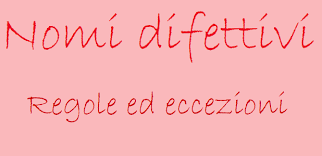
Abbiamo già studiato le due categorie di nomi difettivi: del singolare e
del plurale. Siccome parliamo della grammatica italiana, con tutte le
sue regole ed eccezioni a esse, dobbiamo continuare (sempre con l’aiuto
dell’Enciclopedia Treccani) l’esplorazione dei nomi difettivi.
· Accanto alla forma le assise (‘assemblea giudiziale’), si usano anche le
forme la assise, le assisi, soprattutto con il significato generico di
‘riunione’.
L’assise di Enna, così come quella di Fiuggi, sarà aperta ai contributi
esterni.(www.siciliainformazioni.com)
· Al plurale i nomi dei metalli indicano gli oggetti realizzati con quel
materiale: gli ori della cattedrale, gli argentidella famiglia, gli ottoni
dell’orchestra, i ferri del mestiere.
· I nomi astratti e quelli dei prodotti alimentari, usati al plurale,
indicano il genere specifico: gli amori di George Clooney, i cioccolati del
Belgio, i risi del Pavese.
· La gente ha il plurale ‘le genti’, ‘popoli, nazioni’, di uso ormai poetico:
le genti / del bel paese là dove ’l sì suona (D. Alighieri, Inferno XXXIII
v. 79-80)
DEFECTIVE NOUNS—Part IV
We have already studied the two categories of defective nouns: of the
singular and of the plural. Since we are dealing with Italian grammar,
with all its rules and exceptions to those rules, we have to continue
(always with the help of theEncyclopedia Treccani) our exploration of
defective nouns.
· Along with the plural form “le assise” (court of assizes), we can find
“la assise”, “le assisi” mostly with the generic meaning of ‘reunion’
L’assise of Enna (a city in Sicily), like the one in Fiuggi (a city in
Lazio), will be open to outside duties.
· The names of metals used in the plural form indicate the objects made
with those materials: [literal translations] thegolds of the cathedral,
the family silvers, the brasses of the orchestra, the irons of the trade
(tools of the trade).
· Abstract nouns and the names of foodstuffs in the plural, indicate the
specific type: [literal translations] the loves of George Clooney, Belgian
chocolates, the rices from Pavese.
· “Gente” (singular form for people) has a plural “le genti” to indicate
populations, nations, now only in poetic usage: “… to all the peoples /
of the lovely land where our yes is sounded” (Dante Alighieri, Inferno
XXXIII v. 79-80).
Saturday, April 28, 2018
|
| |
|
NOMI DIFETTIVI-Parte III 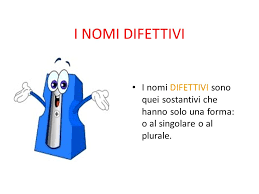
Abbiamo già studiato le due categorie di nomi difettivi: del singolare e
del plurale. Siccome parliamo della grammatica italiana, con tutte le
sue regole ed eccezioni a esse, dobbiamo continuare (sempre con l’aiuto
dell’Enciclopedia Treccani) l’esplorazione dei nomi difettivi.
Molti nomi difettivi presentano in realtà anche la forma mancante, con
varie sfumature di significato.
· Nomi che indicano vestiti o oggetti dell’abbigliamento (pantaloni,
calzoni, occhiali) spesso sono usati al singolare per riferirsi a un
“singolo paio”, “un unico modello”’:
Ho solo un pantalone.
Quell’occhiale le sta proprio bene.
· Nel parlato e nello scritto di livello colloquiale oggi è molto diffuso (di
solito con uso ironico) anche il singolare mutanda.
Ci sono quelli che come per i jeans, fanno vedere la mutanda di
marca.
La bretella, invece, si usa quasi soltanto con il significato diverso di
‘raccordo, collegamento’,
per esempio la bretella autostradale.
· Forbice si usa spesso al singolare, specie nell’espressione colpo di
forbice e con il significato figurato di “distanza, differenza, scarto”:
Passami quella forbice!
DEFECTIVE NOUNS—Part III
We have already studied the two categories of defective nouns: of the
singular and of the plural. Since we are dealing with Italian grammar,
with all its rules and exceptions to those rules, we have to continue
(always with the help of theEncyclopedia Treccani) our exploration of
defective nouns.
Many defective nouns offer even the missing form, often with various
nuances of meaning.
· Nouns that deal with clothing (pants, slacks, glasses) are often used
in the singular to specify “only one pair” or “only one style”.
I only have one pant. [literal translation]
That eyeglass looks great on you. [literal translation]
· In spoken as well as in written contemporary Italian, colloquially
(usually in an ironic sense) to use the singular form of underpants.
There are those who, like with their jeans, show off their designer
underwear.
Suspender, instead is used only to mean the junction, as in a highway.
Scissor is often used in the singular form, as in a scissor strike and with
the figurative meaning of “distance, difference, waste”:
Pass me that scissor!
Saturday, April 21, 2018
|
|
|
| |
NOMI DIFETTIVI del plurale-Parte II 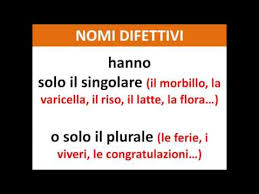
Sono nomi, abbastanza comuni, che hanno solo una forma, quella
singolare o plurale, e se si cerca di usare la forma mancante, ci si
sbaglia.
I nomi difettivi del plurale, in altre parole nomi che sono usati
comunemente al singolare (perché mancanti del plurale—cioè difettivi
del plurale)
· Molti nomi astratti: la pazienza, il coraggio, la superbia, l’amore.
· Nomi che indicano oggetti o cose uniche in natura: l’Equatore, il nord,
il sud, l’Oriente.
· Nomi di malattie: il tifo, la malaria, il vaiolo, l’Aids, il morbillo.
· Nomi che indicano un prodotto alimentare: il cioccolato, il pane, il
miele, il riso.
· Nomi collettivi: la gente, la prole, la roba, il fogliame.
· I nomi di elementi chimici e metalli: l’idrogeno, l’uranio, il mercurio,
il ferro.
· I nomi dei mesi: aprile, maggio, giugno, ecc.
Come così tante cose nella grammatica italiana ci sono eccezioni. Le
esploreremo strada facendo.
[Nota Bene: questi esempi provengono dall’Enciclopedia Treccani]
DEFECTIVE NOUNS of the plural—Part II
They are fairly common words, that have only one form, either singular
or plural, and if you try to use the missing form, you are in error.
Defective nouns of the plural, that is to say, nouns that are commonly
used in the singular (because they are missing the plural form—
therefore defective in the plural)
· Many a abstract nouns: patience, courage,
arrogance, love.
· Nouns that describe objects or unique items in
nature: the Equator, north, south, the Orient.
· Names of diseases: typhus, malaria, smallpox,
Aids, measles.
· Nouns that describe a food type: chocolate, bread,
honey, rice.
· Collective nouns: people, progeny, stuff, foliage.
· Chemical elements and metals: hydrogen, uranium
mercury, iron.
· Months: April, May, June, etc.
However, as many other things in Italian grammar, there
are exceptions. We will explore them next time.
[NOTE: these examples come from the Encyclopedia
Treccani]
Saturday, April 14, 2018
|
|
|
NOMI DIFETTIVI del singolare-Parte I 
Sono nomi, abbastanza comuni, che hanno solo una forma, quella
singolare o plurale, e se si cerca di usare la forma mancante, ci si
sbaglia.
Iniziamo dai nomi difettivi del singolare, in altre parole nomi che sono
usati comunemente al plurale (perché mancanti del singolare—cioè
difettivi del singolare)
· Nomi che indicano oggetti formati da due o più parti: i pantaloni, i
calzoni, gli occhiali, le forbici, le redini, le manette, le bretelle, le
cesoie.
· Nomi che si riferiscono a una pluralità: le stoviglie, i dintorni, le
vicinanze, le spezie, le vettovaglie, le masserizie, le viscere, i viveri,
le percosse, i bronchi, le assise.
· Nomi di uso letterario, che già in latino avevano soltanto il plurale:
le idi, le calende, le none, le ferie, i fasti, gli annali, i posteri, le
nozze, le tenebre.
Come così tante cose nella grammatica italiana ci sono eccezioni. Le
esploreremo strada facendo.
[Nota Bene: questi esempi provengono dall’Enciclopedia Treccani]
DEFECTIVE NOUNS of the singular—Part I
They are fairly common words, that have only one form, either singular
or plural, and if you try to use the missing form, you are in error.
Let’s begin with defective nouns of the singular: that is to say nouns
that are commonly used in the plural (because they are missing the
singular form—therefore defective in the singular)
· Nouns indicating objects formed by two or more parts: trousers,
pants, glasses, scissors, reins, handcuffs, suspenders, shears.
· Nouns indicating plurality: dishes/flatware, surroundings, vicinity,
spices, provisions, furnishings, innards, food, blows, bronchus,
assembly/assizes.
· Literary nouns, which already in Latin had only the plural form: ides,
calends, nones, holidays, pomp, annals, posterity, marriage, darkness.
HOWEVER, as many other things in Italian grammar, there are
exceptions. We will explore them along the way.
Saturday, April 7, 2018
|
|
LA COLOMBA DI PASQUA
In Italia a Pasqua si mangia la colomba. La ditta Motta, che creò il
panettone nel 1919, doveva trovare il modo di sfruttare gli stessi
macchinari e la stessa pasta, e così, negli anni trenta, nacque la
colomba. L’impasto originale è di farina, burro, uova, zucchero, e
buccia d’arancia candita, il tutto coperto da una ricca glassatura
alle mandorle.
|
|
In Italy, at Easter time, Italians eat “Colomba” [the Dove]. In
order to take advantage of the machinery and the dough used to
make the Christmas Panettone, Motta, the company responsible
for its creation in 1919, came up with the Colomba during the
1930’s. The original dough was made from flour, butter, eggs,
sugar, and candied orange peel, all of which is topped with a rich
coating of rock sugar and almonds.
Saturday, March 31, 2018
|
|
|
| |
TRATTARE E TRATTARSI—PARTE IV 
Recentemente in classe una studentessa mi ha domandato la
differenza tra “trattare” e “trattarsi”.
Non è una risposta che si può sbrigare in poche parole. Continuiamo!
Quando il verbo trattarsi è riflessivo, significa:
1. Godere, vivere: Claudio si tratta bene; si tratta proprio da gran
signore.
2. Riguardare: Secondo il commissario di polizia, potrebbe trattarsi di
un duplice omicidio.
3. Concernere: Gianna, lo so che non si tratta di un compito facile, ma
devi farlo, non c’è scelta.
When “trattarsi” is a reflexive verb it means:
1. Enjoy, live: Claudio treats himself well, just like a big shot.
2. Regarding: According to the police detective, it could be about a
double homicide.
3. Concerning: Gianna, I know that it’s not an easy task, but you
have to do it, there’s no choice.
Saturday, March 24, 2018
|
| |
|
| |
TRATTARE E TRATTARSI—PARTE III 
Recentemente in classe una studentessa mi ha domandato la
differenza tra “trattare” e “trattarsi”.
Non è una risposta che si può sbrigare in poche parole. Continuiamo!
Quando il verbo trattare è intransitivo, significa:
1. Discutere: A volte è necessario trattare con il nemico per
raggiungere una pace.
2. Avere a che fare con: Di che tratta il libro che stai leggendo?
3. Accordarsi su un prezzo: Bisogna trattare a lungo prima di
comprare una macchina nuova.
4. Avere rapporti con: Il dirigente non tratta mai con persone che
non conosce bene.
Restate sintonizzati per il prossimo episodio: trattarsi!
When “trattare” is an intransitive verb it means:
1. Negotiate: At times it is necessary to negotiate with the
enemy to attain peace.
2. To be about: The book you are reading, what is it about?
3. To bargain: It is necessary to bargain for a long time before
buying a new car.
4. To deal with: The manager never deals with people he doesn’t
know well.
Stay tuned for the next episode: the reflexive form, “trattarsi”!
Saturday, March 17, 2018
|
| |
|
| |
TRATTARE E TRATTARSI—PARTE II 
Recentemente in classe una studentessa mi ha domandato la
differenza tra “trattare” e “trattarsi”.
Non è una risposta che si può sbrigare in poche parole. Qui
troviamo altri esempi della forma transitiva del verbo:
Quando il verbo trattare è transitivo, significa:
1. Soddisfare (specialmente per albergatori, negozianti, ecc.): In
quell’albergo trattano i clienti molto bene.
2. In chimica: Gli scienziati devono trattare una sostanza con un
reattivo per avere il risultato desiderato.
3. Maneggiare: Quello studente, anche se giovane, tratta il
pennello da maestro.
4. Lavorare: In Giappone il ferro era trattato ripetutamente per
produrre le magnifiche spade dei samurai.
5. Avere relazioni: Oggigiorno molti non trattano certa gente.
Recently in class a student asked me what the difference is
between “trattare” and “trattarsi”. It isn’t an answer that can be
taken care of in a few words. Here are further examples of the
transitive form of the verb:
When “trattare” is a transitive verb it means:
1. To satisfy, take care of (mainly for hoteliers, proprietors, etc.):
In that hotel they treat the guests very well.
2. In chemistry: The scientists have to treat the substance with a
reagent to obtain the desired result.
3. To use, to handle: That student, although still young, handles
his brush like a master.
4. To work, to cure: In Japan, iron was worked repeatedly in order
to produce the magnificent swords of the Samurai.
5. To deal with: These days many will have nothing to do with
certain people.
Stay tuned for the next episode: intransitive “trattare”!
Saturday, March 10, 2018
|
|
| |
TRATTARE E TRATTARSI—PARTE I 
Recentemente in classe una studentessa mi ha domandato la differenza tra
“trattare” e “trattarsi”.
Non è una risposta che si può sbrigare in poche parole. Incominciamo!
Quando il verbo trattare è transitivo, significa:
1. Discutere, sviluppare un tema: La studentessa ha trattato
esaurientemente il tema della sua tesi.
2. Condurre trattative, negoziare: Le due parti hanno trattato l’armistizio
per la divisione del territorio.
3. Comportarsi in un certo modo: La preside tratta gli studenti con rispetto.
4. Trattare qualcuno con gentilezza, come un figlio, da amico, ecc.: Teresa
mi ha sempre trattata con gentilezza, proprio come una sorella.
5. In senso medico, di occuparsi di: La mia dottoressa ha trattato la ferita al
mio ginocchio con cura.
Restate sintonizzati per il prossimo episodio: altri esempi del verbo
transitivo.
Recently in class a student asked me what the difference is between
“trattare” and “trattarsi”. It isn’t an answer that can be taken care of in a few
words. Let’s begin!
. . . . . . . . . . . . . . . .
When “trattare” is a transitive verb it means:
1. To deal with, to treat or discuss or deal with a subject: The student dealt
with the subject of her thesis exhaustively.
2. To negotiate: The two sides negotiated the armistice for the division of
the territory.
3. Act in a certain fashion, handle: The principal treats the students with
respect.
4. To treat someone with kindness, as a son/daughter/friend: Teresa has
always treated me with kindness, just like a sister.
5. Medically: to treat: My doctor treated the wound on my knee with care.
Stay tuned for the next episode: more examples of the transitive forms of
“trattare”!
Saturday, March 3, 2018
|
|
| |
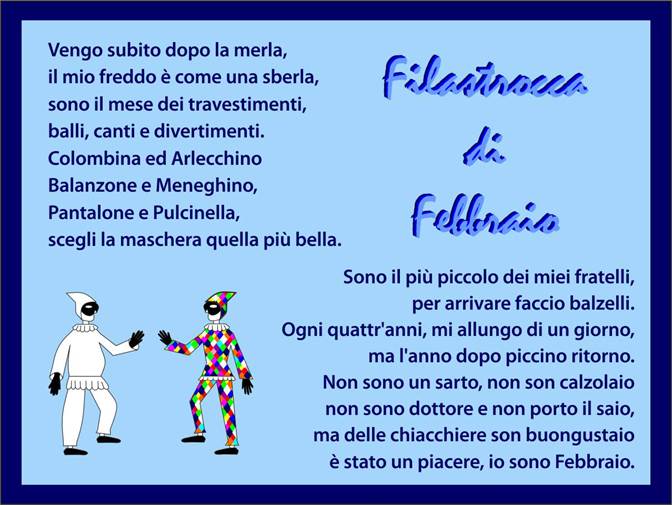
FEBRUARY NURSERY RHYMES:
I come immediately after the blackbird, my cold is like a smack, I am
the month of disguises, dance, song and fun. Colombina and Harlequin,
Balanzone and Meneghino, Pantalone and Punch, choose the most
beautiful mask.
I am the smallest among my brothers, in order to arrive I jump around.
Every four years, I lengthen by one day, but the following year I become
small again. I’m not a tailor, nor a shoemaker, I’m not a doctor and I
don’t wear a habit, but when it comes to chitchat I’m a gourmet. It’s
been a pleasure, I’m February.
Saturday, Feb 24, 2018
|
| |
|
| |
TO SET/ALLESTIRE—PART II 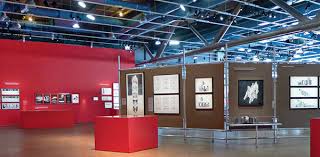
Sappiamo che il verbo “Allestire” può essere usato per preparare una tavola
per il pranzo, ma ha altri significati
1. La vetrina di quel nuovo negozio in via Bissolati è bruttissima! Chi l’avrà
allestita?
2. Vuoi venire con me all’opera domani sera? Danno Otello, e ho sentito
dire che il palcoscenico è stato allestito in un modo spettacolare.
3. La cerimonia di matrimonio del Conte Rossi e della Principessa Bianchini
è stata allestita a Palazzo Farnese.
4. I disegnatori hanno allestito la mostra del mobile all’ultimo momento.
Il verbo allestire però, si usa anche con un esercito, una nave, un aereo, ecc.
. . . . . . . . . . . . . . . .
Per esempio: L’esercito è stato allestito dell’armamento necessario.

We now know that the verb “Allestire” can be used to set a table but it has
other meanings as well.
1. To dress: The window display in that new shop on Via Bissolati is really
ugly! Who could have dressed it?
2. To stage: Would you like to come to the opera with me tomorrow evening?
They are singing Othello, and I’ve heard that the set has been stagedin an
extraordinary way.
3. To set: The wedding ceremony between Count Rossi and Princess Bianchini
was set at Farnese Palace.
4. To organize: The designers organized the furniture fair at the last minute.
The verb “allestire” however, is also used with an army, a ship, a plane, etc.
For example: The army was furnished with all the necessary weaponry.
Saturday, Feb 17, 2018
|
|
| |
TO SET THE TABLE—PART I 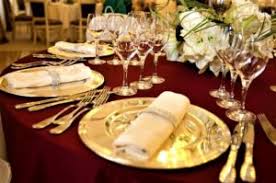
You would like some help setting the table for Sunday dinner from your
Italian-speaking houseguest. You go to your handy dictionary and find that
there are several terms for “to set” a table.
Vorreste dell’aiuto dalla vostra ospite italiana per “set” la tavola per il
pranzo di domenica. Vi rivolgete al vostro vocabolario e scoprite che ci sono
diversi verbi per “to set” un tavolo.
1. Apparecchiare: (preparare la tavola per i pasti) is the most common and
means: to set/prepare the table for meals; Devo apparecchiare la tavola
ma tutti i piatti e le posate sono nella lavastoviglie. I have to set the table
but all the dishes and cutlery are in the dishwasher.
2. Imbandire: (disporre elegantemente la tavola per un pranzo sontuoso)
set/prepare the table for a banquet; A pranzo dalla Regina Elisabetta, il
tavolo e sempre imbandito a perfezione. For dinner at Queen Elisabeth’s,
the table is always set to perfection.
3. Allestire: (predisporre la tavola—ma ha molti altri significati—da
esplorare la prossima volta). This verb has many other meanings in addition
to “setting the table”, which we will explore next time.
Saturday, Feb 10, 2018
|
|
Palazzo della Consulta: sede della Corte Costituzionale
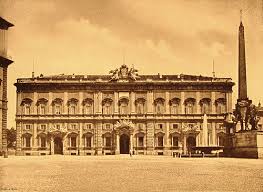
l Palazzo della Consulta (tratto dal sito:
http://www.tesoridiroma.net/palazzi_roma/palazzo_consulta) vasto e
sontuoso palazzo fu costruito sotto il pontificato di Clemente XIII e
destinato al tribunale della sagra consulta, che era una corte Suprema ed
un potere amministrativo, e serviva anche di caserma alla guardia a cavallo
del papa, cioè alla guardia nobile.
Il cav. Ferdinando Fuga fu l'autore di questa costruzione e v'impiegò tutte
le risorse del suo bel talento e fece un appartamento comodo e spazioso
per il segretario dei brevi e della consulta e procurò al corpo dei corazzieri
due entrate comoda e una vasta scuderia, parte della quale è nei
sotterranei. La pianta ha la figura d'un trapezio, una forma ingrata e
obbligata, che il Fuga seppe ridurre bene, fino a dare al palazzo una corte
regolare e spaziosa ed entrate in tutte e quattro le fronti.
La facciata è d'una bella massa e di un’originale e saggia disposizione, nei
due piani interrotti da un mezzanino. Sulla fronte principale vi sono tre
portoni, di cui quello di mezzo è il più sontuoso perché formato da due
colonne doriche sorreggenti un timpano, su cui ai nostri giorni è stato posto
un gruppo statuario sorreggente l'arma reale. Anche sulle altre parti sono
gruppi decorativi.
Il corpo di mezzo è distinto nel piano inferiore da due fasce di bugnato e
nel superiore da quattro pilastri. Il fastigio è coronato da un'artistica loggia,
di gusto discutibile e bizzarro, interrotta nel mezzo dall'arma di Clemente
XIII, sorretta da due fame. Le modanature delle finestre e i vari profili sono
abbastanza curati. Il vestibolo è decorato con semplicità. La scala è a doppi
a rampa e si conserva così fino all'ultimo piano: ha grandi nicchie laterali ed
è notevole il movimento prodotto dalle volte e dalle cupole ellittiche, che le
imprime magnificenza e grandezza. Il cortile è di un'architettura nobile e
semplice e la sua decorazione non risente troppo dei tempi del Fuga: il
portico e la terrazza hanno movimento e vivacità. In fondo al cortile si vede
il vestibolo principale che aggiunge effetto alla massa circostante.
È stata residenza del Ministero degli affari esteri, dal 1955 ha sede la
Corte costituzionale.
[***Ho scelto due versioni diverse invece di tradurre dall’italiano all’inglese,
perché i due siti offrono informazioni diverse e interessanti. Provate voi a
tradurre questa volta—e divertitivi!]
Palazzo della Consulta:
(taken from https://en.wikipedia.org/wiki/Palazzo_della_Consulta) Seat of
the Constitutional Court, built 1732-1735, is a late Baroque palace in
central Rome, Italy, that since 1955 houses the Constitutional Court of the
Italian Republic. It sits across the Piazza del Quirinale from the official
residence of the President of the Italian Republic, the Quirinal Palace.
Prior to the 17th century, a palace had been erected for the Cardinal Ferrero
during the realm of Pope Sixtus V. The Pope Clement XII (Corsini)
commissioned the present palace from Ferdinando Fuga, and it was
completed in 1737 to house the secretariat of the Sacra Congregazione
della Consulta (which served as the main council of state of the Papal
states and tribunal) as well as the Segnatura dei Brevi, as well as two
corps of Papal Guard units. From 1798 to 1814, the palace was used as the
Prefecture of Rome. In 1849, during the Roman Republic, it was the home of
the ruling Triumvirate. After the annexation of the Papal States to the
Kingdom of Italy, from 1871 to 1874, Prince Umberto I and his wife
Margherita of Savoy lived here. From 1874 to 1922, it housed the Ministry of
Foreign Affairs, and from 1924 to 1953 it housed the Ministry of Colonies. In
1955, it became the home of the Constitutional Court of Italy.
Fuga ordered the two-storey facade with a piano nobile whose windows
have low arched heads set in fielded panels, over a ground floor with low
mezzanine. On the lower story the panels have channeled rustication and
rusticated quoins at the corners. Pilasters are applied only to the central
three-bay block, which barely projects, and to the corners. The roof-line of
the facade is topped by a large coat of arms of the Corsini pope, and is
similar to the one of Fontana di Trevi. Lower down, at the entrance, a King
of Italy installed his coat of arms.
The interiors have undergone a series of fresco decorations over the
centuries. The initial 18th-century frescoes by Antonio Bicchierai and
Giovanni Domenico Piastrini, are nearly vanished except for a few allegorical
figures in the apartments of the Cardinals. In 1787, the new Cardinale de
i Brevi, Cardinal Romoaldo Braschi-Onesti, had the palaced redecorated by
Bernardino Nocchi, which was also nearly lost except for frescoes on the
Myth of Proserpine in the "Salone Pompeiano" and decoration in the ceiling
of the "Studio dei Giudici" depicting charity and the four virtues. The Savoy
monarchy had frescoed completed by Domenico Bruschi, Cecrope Barilli and
Annibale Brugnoli.
[***I chose two different versions rather than translate from Italian into
English, because the two sites offer different and interesting facts. You try
to translate this time—and have fun!]
Saturday, Feb 3, 2018
|
|
| |
“TO SIGN” Parte II 
La settimana scorsa abbiamo imparato come tradurre il sostantivo “sign”.
Oggi invece, esaminiamo il verbo “to sign”.
1. Firmare: Il giudice ha firmato il verdetto.
2. Gesticolare: È facile per gli italiani comunicare con i gesti che hanno
fame o sono annoiati.
3. Ingaggiare: La squadra di calcio ha ingaggiato un campione della
squadra avversaria, che mossa brillante!
4. Usare la lingua dei segni: Marietta ha un compagno di scuola sordo, così
ha imparato a usare la lingua dei segni.
5. Rilasciare: La diva del nuovo film ha rilasciato molti autografi dopo aver
vinto l’Oscar.
6. Sottoscrivere: L’amministratore delegato ci ha pensato a lungo prima di
sottoscrivere il nuovo contratto.
. . . . . . . . . . . . . . . .
“TO SIGN” Part II
Last week we learned how to translate the noun “sign”. Today
we will look at the verb “to sign”.
1. The judge signed the judgment.
2. It’s easy for Italians to sign that they are hungry or bored.
3. The football team signed a champion from the opposing
team, what a coup!
4. Marietta has a schoolmate who is deaf, so she learned how
to sign.
5. The movie star signed many autographs after winning the
Oscar.
6. The CEO thought for a long time before agreeing to sign
the new contract.
Saturday, January 27, 2018
|
|
“SIGN” Parte I 
Il termine “sign” in inglese può essere tradotto in vari modi in italiano.
Oggi esaminiamo i sostantivi, la settimana prossima i verbi:.
1. Cartello: Sulla porta della biblioteca c’era appeso un cartello con le ore
di apertura e chiusura.
2. Segnale stradale: Anche se il segnale indicava di dare la precedenza, il
ciclista non si è nemmeno rallentato.
3. Segno zodiacale: Di che segno sei? Stai scherzando, vero?
4. Avvisaglia: Ci sono avvisaglie che domani farà brutto tempo? Spero
proprio di no.
5. Segno: Il segno che Mario ha avuto dalla chiromante era tutto sbagliato,
ma lui ci ha creduto lo stesso.
6. Simbolo: Che cosa significa il carattere tipografico #?
7. Insegna: I negozi al centro sono costretti di avere insegne di una certa
misura.
8. Cenno/gesto/segno: Dopo la sua caduta sul ghiaccio, Anna ha fatto
cenno che non si era fatta male.
9. Sintomo/traccia: Roberto si è talmente ingrassato che ora mostra
sintomi di diabete.
“SIGN” Part I
The English term “sign” can be translated in different ways in Italian.
Today we will look at nouns, next week, at verbs.
1. On the door of the library there was hung a sign stating the opening and
closing time.
2. Even if the road sign said to yield, the bicyclist didn’t even slow down.
3. What’s your sign of the zodiac? You’re kidding, aren’t you?
4. Are there warning signs that tomorrow the weather will be bad? I surly
hope not.
5. The (portent) sign that Mario received from the fortune teller was all
wrong, but he believed it anyway.
6. What does the sign (typographical character) # mean?
7. The stores in the center of town are required to have shop signs of a
certain size.
8. After her fall on the ice, Anna gave us a sign that she hadn’t hurt herself.
9. Roberto has gained so much weight that now he is showing signs of
diabetes.
Saturday, January 20, 2018
|
|
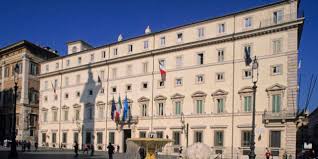
Palazzo Chigi, la storia (tratto dal sito: http://www.governo.it: Governo
Italiano Presidenza del Consiglio dei Ministri.)
Palazzo Chigi è la sede del Governo italiano dal 1961. Si trova in un punto
del centro storico di Roma tra i più conosciuti: lungo via del Corso, quasi a
metà strada tra Piazza del Popolo e Piazza Venezia. L'ingresso del Palazzo
è su Piazza Colonna e la bimillenaria Colonna di Marco Aurelio, che dà il
nome alla Piazza, è proprio di fronte al portone. Il Palazzo, inoltre, confina
su lato destro con la sede della Camera dei deputati.
La storia architettonica attraversa più di tre secoli nel corso dei quali si sono
succeduti diversi progetti e continui adattamenti alle sempre nuove esigenze
del Palazzo. Quello che sarà il futuro Palazzo Chigi, all'atto dell'acquisto da
parte degli Aldobrandini (1578) è un gruppo di casupole appartenenti a varie
famiglie che sono riedificate dopo essere state abbattute. Dal 1578 si
comincia a costruire il volto di Palazzo Chigi che segue e accompagna lo
sviluppo dell'intera zona.
Le fasi più importanti della costruzione dell'edificio si svolgono in questi
anni, anche se continuano nel corso del ‘600; mentre gli adattamenti degli
ambienti interni mutano con i proprietari che si avvicendano per tutto il
secolo. Gli ultimi e definitivi ammodernamenti sono realizzati dopo il
passaggio del Palazzo allo Stato (1916), che diventa prima sede del
ministero delle Colonie e poi del Ministero degli Esteri.
Dopo un paio di secoli in cui l'edificio è servito prevalentemente ad
abitazione di famiglie importanti della Roma papalina, dalla fine del '700, il
palazzo vede la presenza più o meno stabile dell'ambasciata spagnola a
Roma. Nel corso del 1800, diventa il luogo di accordi e alleanze. Dal 1878
diventa sede dell'ambasciatore d'Austria-Ungheria presso il Quirinale. È in
questo periodo che il Palazzo è soprannominato la "mole Austro-vaticana".
Agli inizi del 1900, nonostante la presenza dei principi Chigi in veste di
padroni di casa, il Palazzo è, di fatto, la sede dell'ambasciata austriaca e
come tale sottoposto alle frequenti manifestazioni irredentiste per Trento e
Trieste.
Nel 1916 lo Stato acquista Palazzo Chigi con l'intenzione di destinarlo a
ministero delle Colonie. Nel 1922, Mussolini trasferisce questo ministero nel
Palazzo della Consulta, davanti al Quirinale, e destina Palazzo Chigi a sede
del Ministero degli Esteri. Mussolini, che ricopre la doppia carica di Presidente
del Consiglio eministro degli Esteri, diventa così il nuovo inquilino di Palazzo
Chigi.
Palazzo Chigi rimane sede del ministero degli Esteri fino al 1961.
[***Ho scelto due versioni diverse invece di tradurre dall’italiano all’inglese,
perché i due siti offrono informazioni differenti e interessanti. Provate voi a
tradurre questa volta—e divertitivi!]
PALAZZO CHIGI: RESIDENCE OF THE PRIME MINISTER
The Palazzo Chigi (copied from https://en.wikipedia.org/wiki/Palazzo_Chigi)
is a palace or noble residence in Rome and the official residence of the Prime
Minister of the Italian Republic. Since December 12, 2016, the occupant of
Palazzo Chigi is Paolo Gentiloni.
The Palazzo, overlooking the Piazza Colonna and the Via del Corso, was
begun in 1562 by Giacomo della Porta and completed by Carlo Maderno in
1580 for the Aldobrandini family. In 1659 it was purchased by the Chigi family.
It was then remodeled by Felice della Greca and Giovan Battista Contini. It
has five floors, a broad stairway that leads to the living rooms, and a
courtyard decorated with a fountain, designed by Giacomo della Porta. The
fountain has been copied in many sites in Rome and other Italian cities.
In 1878 it became the residence of the Austro-Hungarian Ambassador to Italy.
In 1916 it was bought by the Italian state and became the seat of the
Minister for Colonial Affairs. Later it was the official residence of the Italian
Minister of Foreign Affairs. In 1961 it became the official meeting place of
Council of Ministers whose President is the head of the Italian government.
The Library Hall was commissioned by Agostino Chigi at the end of the 17th
century in order to house the enormous library of Cardinal Flavio Chigi. The
project was realized by Giovan Battista Contini, a famous architect of the
period. The Chigi library or Chigiana contained thousands of valuable
manuscripts, to a large part based on the personal library of Pope Alexander
VII, a member of the Chigi family. Since the time of Pope Benedict XV, the
Vatican attempted to acquire this library, but lacked the necessary funds.
Eventually, Pietro Tacchi Venturi was tasked by Pope Pius XI to negotiate the
purchase with the newly formed fascist government of Benito Mussolini.
Venturi managed to convince Mussolini to donate the library to the Vatican
free of charge.
[***I chose two different versions rather than translate from Italian into
English, because the two sites offer varying and interesting facts. You try to
translate this time—and have fun!]
Saturday, January 13, 2018
|
| |
Epifania o Befana 
Questa festa è celebrata il 6 gennaio. Il significato e l’etimologia
(secondo Garzanti Linguistica) sono:
1. (relig.) (con iniziale maiuscola) manifestazione della divinità, del
soprannaturale; in particolare, festività cristiana che si celebra il 6
gennaio a ricordo della visita dei Magi a Gesù e delle prime
manifestazioni della sua divinità
2. (non com.) apparizione, manifestazione solenne
Etimologia: ← dal lat. tardo epiphanīa(m), o epiphanĭa(m), che è dal gr.
epipháneia, in origine agg. neutro pl., ‘(feste) dell’apparizione’, deriv. di
epiphánein ‘apparire (phánein) da sopra (epí)’.
Ai bambini però, non gliene importa per niente; appendono le loro
calze e sperano che siano piene di caramelle invece che carbone.
This holiday is celebrated on January 6th. Its meaning and etymology
(according to Garzanti’s linguistic dictionary) are:
1. (religious) (with a capital letter) manifestation of the divinity, the
supernatural; particularly, a Christian holiday that is celebrated the 6th
of January to commemorate the visit of the Magi to Jesus and of the
first manifestations of his divinity.
2. (not common) apparition, solemn manifestation.
Etymology: from late Latin epiphanīa(m), or epiphanĭa(m), which comes
from the Greek epipháneia, originally a neutral plural adjective, derived
from epiphánein to appear (phánein) from above (epí)’.
Children however, couldn’t care less; they hang their stockings and
hope to find them full of candy rather than coal.
Saturday, January 6, 2018
|
. . . . . . . . . . . . . . . .
|
|

Blog Pages/Years
2025 | 2024 | 2023 | 2022 | 2021 | 2020 | 2019 | 2018 | 2017 | 2016 | 2015 | 2014 |
|
|
|
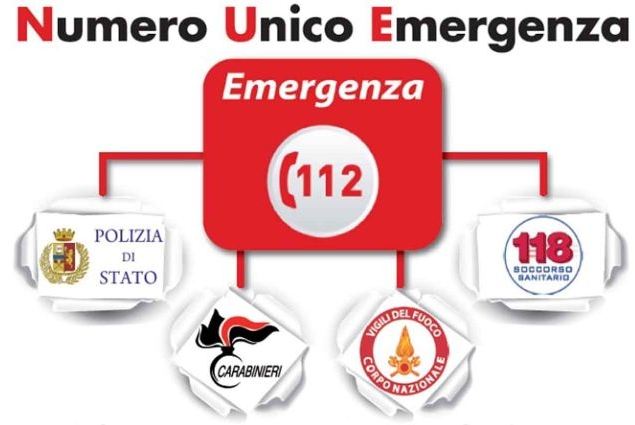
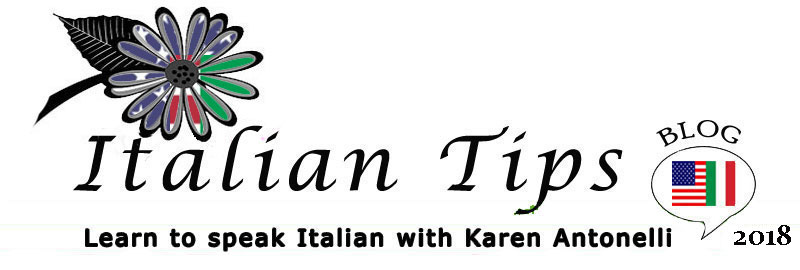





 gnocchi di patate dolci
gnocchi di patate dolci frittata di patate dolci con
frittata di patate dolci con  gelato di patate dolci
gelato di patate dolci


























 It’s hot in Italy during the summer and you are
It’s hot in Italy during the summer and you are 















